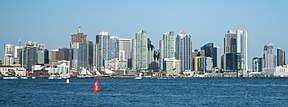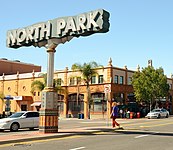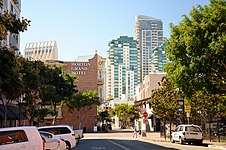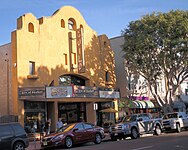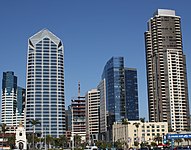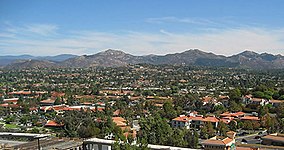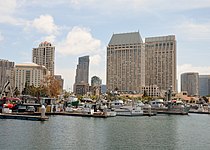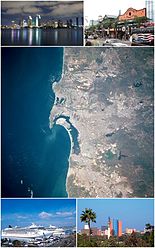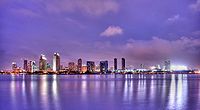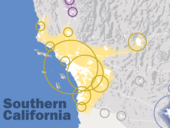San Diego
San Diego | |
|---|---|
|
| |
| Nicknames: | |
| Motto: Semper Vigilans(Latinfor 'Ever Vigilant') | |
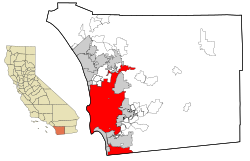 Location of San Diego inSan Diego County, California | |
| Coordinates:32°42′54″N117°09′45″W/ 32.71500°N 117.16250°W | |
| Country | |
| State | |
| County | |
| Established | July 16, 1769 |
| Incorporated | March 27, 1850[3] |
| Named for | Saint Didacus of Alcalá |
| Government | |
| • Type | Strong Mayor[4] |
| • Body | San Diego City Council |
| •Mayor | Todd Gloria(D) |
| •City Attorney | Mara Elliott(D)[5] |
| •City Council[6] | List |
| •State Assembly Members | List
|
| •State Senators | List
|
| Area | |
| • Total | 372.42 sq mi (964.56 km2) |
| • Land | 325.88 sq mi (844.02 km2) |
| • Water | 46.54 sq mi (120.54 km2) 12.68% |
| Highest elevation | 1,591 ft (485 m) |
| Lowest elevation | 0 ft (0 m) |
| Population | |
| • Total | 1,386,932 |
| • Estimate (2021)[9] | 1,381,611 |
| • Rank | 19thin North America 8thin the United States 2ndin California |
| • Density | 4,255.96/sq mi (1,643.25/km2) |
| •Urban | 3,070,300 (US:15th) |
| • Urban density | 4,550.5/sq mi (1,756.9/km2) |
| •Metro | 3,276,208 (US:18th) |
| Demonym | San Diegan |
| GDP | |
| • San Diego (MSA) | $295.6 billion (2022) |
| Time zone | UTC−08:00(PST) |
| • Summer (DST) | UTC−07:00(PDT) |
| ZIP Codes[13] | 92101–92124, 92126–92132, 92134–92140, 92142-92143, 92145, 92147, 92149–92150, 92152-92155, 92158–92161, 92163, 92165–92179, 92182, 92186-92187, 92191–92193, 92195-92199 |
| Area codes | 619/858 |
| FIPS code | 06-66000 |
| GNISfeature IDs | 1661377,2411782 |
| Website | www |
San Diego(⫽ˌsændiˈeɪɡoʊ⫽SANdee-AY-goh,Spanish:[sanˈdjeɣo]) is a city on thePacific Oceancoast inSouthern Californialocated immediately adjacent to theMexico–United States border.With a population of over 1.3 million residents, the city is theeighth-most populous in the United Statesand thesecond-most populousin thestateofCaliforniaafterLos Angeles.The city is thecounty seatofSan Diego County,which had a population of nearly 3.3 million people as of 2021[update].[15]San Diego is known for its mild year-roundMediterranean climate,extensivebeachesandparks,its long association with theUnited States Navy,and its recent emergence as ahealthcareandbiotechnologydevelopment center.
Historically home to theKumeyaayNative Americans, San Diego has been referred to as theBirthplace of California,as it was the first site visited and settled by Europeans on what is now theWest Coast of the United States.[16]Upon landing inSan Diego Bayin 1542,Juan Rodríguez Cabrilloclaimed the area forSpain,forming the basis for the settlement ofAlta California200 years later. ThePresidioandMission San Diego de Alcalá,founded in 1769, formed the first European settlement in what is now California. In 1821, San Diego became part of the newly declaredMexican Empire,which reformed as theFirst Mexican Republictwo years later. California was conquered by the U.S. in 1848 following theMexican–American Warand wasadmitted to the union as a state in 1850.
San Diego's main economic enginesare military and defense-related activities, tourism, international trade, research, and manufacturing. The city is home to several universities, includingUC San Diego,San Diego State University,and theUniversity of San Diego.San Diego is the economic center of theSan Diego–Tijuanaconurbation,the second-most populoustransborder metropolitan areain theWestern Hemisphere,home to an estimated 5 million people as of 2022.[17]The primary border crossing between San Diego andTijuana,theSan Ysidro Port of Entry,is the busiest international land border crossing in the world outside of Asia (fourth-busiestoverall). The city's airport,San Diego International Airport,is the busiest single-runwayairport in the United States.[18]
Name[edit]
Etymology[edit]
San Diego's name can be traced back to the 16th century when Spanish explorerSebastián Vizcaínobestowed it upon the area in 1602. He named the bay and the surrounding area "San Diego de Alcalá" in honor ofSaint Didacus of Alcalá.[19]
Kumeyaay Toponymy[edit]
Prior to the Spanish establishment of San Diego, theKumeyaaytown was calledKosa'aay,meaning "drying out place" in theKumeyaay language.[20]After the establishment of San Diego, the Kumeyaay called town and cityTepacul Watai,meaning "Stacked Big".[21]Luiseñospeakers in theNorth County regioncalled itPushuyi.[22]
History[edit]
Pre-colonial period[edit]

What has been referred to as theSan Dieguito complexwas established in the area at least 9,000 years ago.[23]TheKumeyaaymay have culturally evolved from this complex or migrated into the area around 1000 C.E.[24]ArchaeologistMalcolm Rogershypothesized that the early cultures of San Diego were separate from theKumeyaay,yet this claim is disputed, with others noting that it does not account forcultural evolution.[25]Rogers later reevaluated his claims, yet they were influential in shaping historical tellings of early San Diego history.[25]
The Kumeyaay established villages scattered across the region, including the village ofKosa'aaywhich was the Kumeyaay village that the future settlement of San Diego would stem from in today'sOld Town.[20][26]The village of Kosa'aay was made up of thirty to forty families living in pyramid-shaped housing structures and was supported by a freshwater spring from the hillsides.[20]
Spanish period[edit]

The first European to visit the region was explorerJuan Rodríguez Cabrillo,sailing under the flag ofCastilebut possiblyborn in Portugal.Sailing his flagshipSan SalvadorfromNavidad,New Spain, Cabrillo claimed the bay for theSpanish Empirein 1542, and named the site "San Miguel".[27]In November 1602,Sebastián Vizcaínowas sent to map the California coast. Arriving on his flagshipSan Diego,Vizcaíno surveyed the harbor and what are nowMission BayandPoint Lomaand named the area for the CatholicSaint Didacus,aSpaniardmore commonly known asSan Diego de Alcalá.On November 12, 1602, the first Christian religious service of record inAlta Californiawas conducted by Friar Antonio de la Ascensión, a member of Vizcaíno's expedition, to celebrate the feast day of San Diego.[19]
The permanentEuropean colonizationof both California and San Diego began in 1769 with the arrival of four contingents of Spaniards from New Spain and theBaja Californiapeninsula. Two seaborne parties reached San Diego Bay: theSan Carlos,under Vicente Vila and including as notable members the engineer and cartographerMiguel Costansóand the soldier and future governorPedro Fages,and theSan Antonio,underJuan Pérez.An initial overland expedition to San Diego from the south was led by the soldierFernando Riveraand included theFranciscanmissionary, explorer, and chroniclerJuan Crespí,followed by a second party led by the designated governorGaspar de Portolàand including the mission president (and now saint)Junípero Serra.[28]

In May 1769, Portolà established the FortPresidio of San Diegoon a hill near theSan Diego Riverabove the Kumeyaay village of Cosoy,[20]which would later become incorporated into the Spanish settlement,[26]making it the first settlement by Europeans in what is now the state of California. In July of the same year,Mission San Diego de Alcaláwas founded by Franciscan friars under Serra.[29][30]The mission became a site for a Kumeyaay revolt in 1775, which forced the mission to relocate six miles (10 km) up the San Diego River.[31]By 1797, the mission boasted the largest native population in Alta California, with over 1,400 neophytes living in and around the mission proper.[32]Mission San Diego was the southern anchor inAlta Californiaof the historic mission trailEl Camino Real.Both the Presidio and the Mission areNational Historic Landmarks.[33][34]
Mexican period[edit]
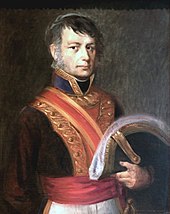
In 1821,Mexicowon its independence from Spain,and San Diego became part of the Mexican territory ofAlta California.In 1822, Mexico began its attempt to extend its authority over the coastal territory of Alta California. The fort on Presidio Hill was gradually abandoned, while the town of San Diego grew up on the level land below Presidio Hill. The Mission wassecularized by the Mexican government in 1834,and most of the Mission lands were granted to former soldiers. The 432residentsof the town petitioned the governor to form apueblo,andJuan María Osunawas elected the firstalcalde( "municipal magistrate" ), defeatingPío Picoin the vote. Beyond the town, Mexicanland grantsexpanded the number ofCalifornia ranchosthat modestly added to the local economy. (See,List of pre-statehood mayors of San Diego.)
However, San Diego had been losing population throughout the 1830s, due to increasing tension between the settlers and the indigenousKumeyaayand in 1838 the town lost its pueblo status because its size dropped to an estimated 100 to 150 residents.[35]Theranchosin the San Diego region would face Kumeyaay raids in the late 1830s and the town itself would face raids in the 1840s.[36]
Americans gained an increased awareness of California, and its commercial possibilities, from the writings of two countrymen involved in the often officially forbidden, to foreigners, but economically significant hide and tallow trade, where San Diego was a major port and the only one with an adequate harbor:William Shaler's "Journal of a Voyage Between China and the North-Western Coast of America, Made in 1804" andRichard Henry Dana's more substantial and convincing account, of his 1834–36 voyage, the classicTwo Years Before the Mast.[37]

In 1846, the United States went to war against Mexico and sent a naval and landexpedition to conquer Alta California.At first, they had an easy time of it, capturing the major ports including San Diego, but the Californios in southern Alta California struck back. Following the successful revolt inLos Angeles,the American garrison at San Diego was driven out without firing a shot in early October 1846. Mexican partisans held San Diego for three weeks until October 24, 1846, when the Americans recaptured it. For the next several months the Americans were blockaded inside the pueblo. Skirmishes occurred daily and snipers shot into the town every night. The Californios drove cattle away from the pueblo hoping to starve the Americans and their Californio supporters out. On December 1, the American garrison learned that the dragoons of GeneralStephen W. Kearneywere atWarner's Ranch.CommodoreRobert F. Stocktonsent a mounted force of fifty under CaptainArchibald Gillespieto march north to meet him. Their joint command of 150 men, returning to San Diego, encountered about 93 Californios underAndrés Pico.
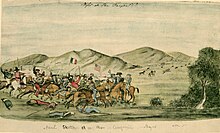
In the ensuingBattle of San Pasqual,fought in theSan Pasqual Valleywhich is now part of the city of San Diego, the Americans suffered their worst losses in the campaign. Subsequently, a column led by Lieutenant Gray arrived from San Diego, rescuing Kearny's battered and blockaded command.[38]Stockton and Kearny went on to recover Los Angeles and force the capitulation of Alta California with the "Treaty of Cahuenga"on January 13, 1847. As a result of theMexican–American Warof 1846–48, the territory of Alta California, including San Diego, was ceded to the United States by Mexico, under the terms of theTreaty of Guadalupe Hidalgoin 1848. The Mexican negotiators of that treaty tried to retain San Diego as part of Mexico, but the Americans insisted that San Diego was "for every commercial purpose of nearly equal importance to us with that of San Francisco", and the Mexican–American border was eventually established to be one league south of the southernmost point ofSan Diego Bay,so as to include the entire bay within the United States.[39]
American period[edit]

The state of California was admitted to the United States in 1850. That same year San Diego was designated the seat of the newly established County of San Diego and was incorporated as a city.Joshua H. Bean,the last alcalde of San Diego, was elected the first mayor. Two years later the city was bankrupt;[40]the California legislature revoked the city's charter and placed it under control of a board of trustees, where it remained until 1889. A city charter was reestablished in 1889, and today's city charter was adopted in 1931.[41]
The original town of San Diego was located at the foot of Presidio Hill, in the area which is nowOld Town San Diego State Historic Park.The location was not ideal, being several miles away from navigable water at its port atLa Playa.In 1850,William Heath Davispromoted a new development by the bay shore called "New San Diego", several miles south of the original settlement; however, for several decades the new development consisted only of a pier, a few houses and anArmy depotfor the support ofFort Yuma.After 1854, the fort became supplied by sea and bysteamboats on the Colorado Riverand the depot fell into disuse. From 1857 to 1860, San Diego became the western terminus of theSan Antonio-San Diego Mail Line,the earliest overlandstagecoachand mail operation from theEastern United Statesto California, coming fromTexasthroughNew Mexico Territoryin less than 30 days.[42]
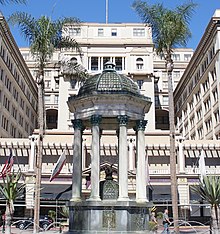
In the late 1860s,Alonzo Hortonpromoted a move to the bayside area, which he called "New Town" and which becameDowntown San Diego.Horton promoted the area heavily, and people and businesses began to relocate to New Town because its location onSan Diego Baywas convenient to shipping. New Town soon eclipsed the original settlement, known to this day asOld Town,and became the economic and governmental heart of the city.[43]Still, San Diego remained a relative backwater town until the arrival of a railroad connection in 1878. In 1884–1886,John J. Montgomerymade the first controlled flights by an American in a heavier-than-air unpowered glider just south of San Diego at Otay Mesa, helping to pioneer a new science of aerodynamics.
In 1912, San Diego was the site of afree speech fightbetween theIndustrial Workers of the Worldand the city government who passed an ordinance forbidding thefreedom of speechalong an area of "Soapbox Row" that led to civil disobedience,vigilantism,police violence,the abduction ofEmma Goldman's husbandBen Reitmanandmultiple riots.[44][45]San Diego's proximity to Tijuana during theMexican Revolutionmade this one of the most significantfree speech fightsduring theWobblyera.[46]
In 1916, the neighborhood ofStingaree,the original home of San Diego's firstChinatownand "Soapbox Row", was demolished by anti-vicecampaigners to make way for theGaslamp Quarter.[47]

In the early part of the 20th century, San Diego hosted theWorld's Fairtwice: thePanama-California Exposition (1915)and theCalifornia Pacific International Expositionin 1935. Both expositions were held inBalboa Park,and many of the Spanish/Baroque-style buildings that were built for those expositions remain to this day as central features of the park. The buildings were intended to be temporary structures, but most remained in continuous use until they progressively fell into disrepair. Most were eventually rebuilt, using castings of the original façades to retain the architectural style.[48]The menagerie of exotic animals featured at the 1915 exposition provided the basis for theSan Diego Zoo.[49]During the 1950s there was a citywide festival calledFiesta del Pacificohighlighting the area's Spanish and Mexican past.[50]In the 2010s there was a proposal for a large-scale celebration of the 100th anniversary of Balboa Park, but the plans were abandoned when the organization tasked with putting on the celebration went out of business.[51]
The southern portion of thePoint Lomapeninsula was set aside for military purposes as early as 1852. Over the next several decades theArmyset up a series of coastal artillery batteries and named the areaFort Rosecrans.[52]Significant U.S. Navy presence began in 1901 with the establishment of the Navy Coaling Station in Point Loma, and expanded greatly during the 1920s.[53]By 1930, the city was host toNaval Base San Diego,Naval Training Center San Diego,San Diego Naval Hospital,Camp Matthews,andCamp Kearny(nowMarine Corps Air Station Miramar). The city was also an early center for aviation: as early as World War I, San Diego was proclaiming itself "The Air Capital of the West".[54]The city was home to important airplane developers and manufacturers like Ryan Airlines (laterRyan Aeronautical), founded in 1925, andConsolidated Aircraft(laterConvair), founded in 1923.[55]Charles A. Lindbergh's planeThe Spirit of St. Louiswas built in San Diego in 1927 by Ryan Airlines.[54]

DuringWorld War II,San Diego became a major hub of military and defense activity, due to the presence of so many military installations and defense manufacturers. The city's population grew rapidly during and after World War II, more than doubling between 1930 (147,995) and 1950 (333,865).[56]During the final months of the war, the Japanese had a plan to target multiple U.S. cities forbiological attack,starting with San Diego. The plan was called "Operation Cherry Blossoms at Night"and called forkamikazeplanes filled with fleas infected with plague (Yersinia pestis) to crash into civilian population centers in the city, hoping to spread plague in the city and effectively kill tens of thousands of civilians. The plan was scheduled to launch on September 22, 1945, but was not carried out becauseJapan surrenderedfive weeks earlier.[57][58][59]
After World War II, the military continued to play a major role in the local economy, but post-Cold Warcutbacks took a heavy toll on the local defense and aerospace industries. The resulting downturn led San Diego leaders to seek to diversify the city's economy by focusing on research and science, as well as tourism.[60]

From the start of the 20th century through the 1970s, the Americantunafishing fleet and tuna canning industry were based in San Diego, "the tuna capital of the world".[61]San Diego's first tuna cannery was founded in 1911, and by the mid-1930s the canneries employed more than 1,000 people. A large fishing fleet supported the canneries, mostly staffed by immigrant fishermen fromJapan,and later from thePortugueseAzoresandItalywhose influence is still felt in neighborhoods likeLittle ItalyandPoint Loma.[62][63]Due to rising costs and foreign competition, the last of the canneries closed in the early 1980s.[64]
Downtown San Diego was in decline in the 1960s and 1970s, but experienced some urban renewal since the early 1980s, including the opening ofHorton Plaza,the revival of theGaslamp Quarter,and the construction of theSan Diego Convention Center;Petco Parkopened in 2004.[65]Outside of downtown, San Diego annexed large swaths of land and for suburban expansion to the north and control of theSan Ysidro Port of Entry.
As theCold Warended, the military shrank and so did defense spending. San Diego has since become a center of the emerging biotech industry and is home to telecommunications giantQualcomm.San Diego had also grown in the tourism industry with the popularity of attractions such as theSan Diego Zoo,SeaWorld San Diego,andLegoland CaliforniainCarlsbad.[citation needed]
Geography[edit]

According to SDSU professor emeritus Monte Marshall,San Diego Bayis "the surface expression of a north-south-trending, nestedgraben".TheRose CanyonandPoint Lomafault zonesare part of theSan Andreas Faultsystem. About 40 miles (64 km) east of the bay are theLaguna Mountainsin thePeninsular Ranges,which are part of thebackbone of the American continents.[66]
The city lies on approximately 200 deep canyons and hills separating itsmesas,creating small pockets of natural open space scattered throughout the city and giving it a hilly geography.[67]Traditionally, San Diegans have built their homes and businesses on the mesas, while leaving the urban canyons relatively wild.[68]Thus, the canyons give parts of the city a segmented feel, creating gaps between otherwise proximate neighborhoods and contributing to a low-density, car-centered environment. TheSan Diego Riverruns through the middle of San Diego from east to west, creating a river valley that serves to divide the city into northern and southern segments. During the historic period and presumably earlier as well, the river has shifted its flow back and forth between San Diego Bay and Mission Bay, and itsfresh waterwas the focus of the earliest Spanish explorers.Miguel Costansó,a cartographer, wrote in 1769, "When asked by signs where the watering-place was, the Indians pointed to a grove which could be seen at a considerable distance to the northeast, giving to understand that a river or creek flowed through it, and that they would lead our men to it if they would follow."[69][70]That river was the San Diego River.[69]Several reservoirs andMission Trails Regional Parkalso lie between and separate developed areas of the city.

Notable peaks within the city limits includeCowles Mountain,the highest point in the city at 1,591 feet (485 m);[8]Black Mountainat 1,558 feet (475 m); andMount Soledadat 824 feet (251 m). TheCuyamaca Mountainsand Laguna Mountains rise to the east of the city, and beyond the mountains are desert areas. TheCleveland National Forestis a half-hour drive from downtown San Diego. Numerous farms are found in the valleys northeast and southeast of the city.
Climate[edit]
| San Diego | ||||||||||||||||||||||||||||||||||||||||||||||||||||||||||||
|---|---|---|---|---|---|---|---|---|---|---|---|---|---|---|---|---|---|---|---|---|---|---|---|---|---|---|---|---|---|---|---|---|---|---|---|---|---|---|---|---|---|---|---|---|---|---|---|---|---|---|---|---|---|---|---|---|---|---|---|---|
| Climate chart (explanation) | ||||||||||||||||||||||||||||||||||||||||||||||||||||||||||||
| ||||||||||||||||||||||||||||||||||||||||||||||||||||||||||||
| ||||||||||||||||||||||||||||||||||||||||||||||||||||||||||||
Under theKöppen–Geiger climate classification system,the San Diego area has been variously categorized as having either ahot semi-arid climate(BShin the original classification[72]andBSknin modified Köppen classification with the n denoting summer fog)[73]or ahot-summer Mediterranean climate[74](Csa).[75]San Diego's climate is characterized by warm, dry summers and mild winters, with most of the annual precipitation falling between December and March. The city has a mild climate year-round,[76]with an average of 201 days above 70 °F (21 °C) and low rainfall (9–13 inches [230–330 mm] annually).
The climate in San Diego, like most of Southern California, often varies significantly over short geographical distances, resulting inmicroclimates.In San Diego, this is mostly because of the city's topography (the Bay, and the numerous hills, mountains, and canyons). Frequently, particularly during the "May gray/June gloom"period, a thick"marine layer"cloud cover keeps the air cool and damp within a few miles of the coast, but yields to bright cloudless sunshine approximately 5–10 miles (8–16 km) inland.[77]Sometimes the June gloom lasts into July, causing cloudy skies over most of San Diego for the entire day.[78][79]Even in the absence of June gloom, inland areas experience much more significant temperature variations than coastal areas, where the ocean serves as a moderating influence. Thus, for example, downtown San Diego averages January lows of 50 °F (10 °C) and August highs of 78 °F (26 °C). The city ofEl Cajon,just 12 miles (19 km) inland from downtown San Diego, averages January lows of 42 °F (6 °C) and August highs of 88 °F (31 °C).
The average surface temperature of the water at Scripps Pier in theCalifornia Currenthas increased by almost 3 °F (1.7 °C) since 1950, according to scientists atScripps Institution of Oceanography.[80]Additionally, the mean minimum is now above 40 °F (4 °C), putting San Diego inhardiness zone11, with the last freeze having occurred many decades ago.

Annual rainfall along the coast averages 10.65 inches (271 mm) and the median is 9.6 inches (240 mm).[81]The months of December through March supply most of the rain, with February the only month averaging 2 inches (51 mm) or more. The months of May through September tend to be almost completely dry. Although there are few wet days per month during the rainy period, rainfall can be heavy when it does fall. Rainfall is usually greater in the higher elevations of San Diego; some of the higher areas can receive 11–15 inches (280–380 mm) per year. Variability from year to year can be dramatic: in the wettest years of 1883/1884 and 1940/1941, more than 24 inches (610 mm) fell, whilst in the driest years there was as little as 3.2 inches (80 mm). The wettest month on record is December 1921 with 9.21 inches (234 mm).
Snow in the city is rare, having been observed only six times in the century and a half that records have been kept. In 1949 and 1967, snow remained on the ground for a few hours in higher locations likePoint LomaandLa Jolla.The other three occasions, in 1882, 1946, and 1987, involved flurries but no accumulation.[82]On February 21, 2019, snow fell and accumulated in residential areas of the city, but none fell in the downtown area.[83]
| Month | Jan | Feb | Mar | Apr | May | Jun | Jul | Aug | Sep | Oct | Nov | Dec | Year |
|---|---|---|---|---|---|---|---|---|---|---|---|---|---|
| Record high °F (°C) | 88 (31) |
91 (33) |
99 (37) |
98 (37) |
98 (37) |
101 (38) |
100 (38) |
98 (37) |
111 (44) |
107 (42) |
100 (38) |
88 (31) |
111 (44) |
| Mean maximum °F (°C) | 78.8 (26.0) |
78.6 (25.9) |
80.2 (26.8) |
82.1 (27.8) |
79.3 (26.3) |
79.6 (26.4) |
82.9 (28.3) |
85.2 (29.6) |
90.6 (32.6) |
87.8 (31.0) |
85.4 (29.7) |
77.0 (25.0) |
94.0 (34.4) |
| Mean daily maximum °F (°C) | 66.4 (19.1) |
66.2 (19.0) |
67.0 (19.4) |
68.8 (20.4) |
69.5 (20.8) |
71.7 (22.1) |
75.3 (24.1) |
77.3 (25.2) |
77.2 (25.1) |
74.6 (23.7) |
70.7 (21.5) |
66.0 (18.9) |
70.9 (21.6) |
| Daily mean °F (°C) | 58.4 (14.7) |
59.0 (15.0) |
60.7 (15.9) |
62.9 (17.2) |
64.8 (18.2) |
67.2 (19.6) |
70.7 (21.5) |
72.4 (22.4) |
71.7 (22.1) |
68.1 (20.1) |
62.7 (17.1) |
57.9 (14.4) |
64.7 (18.2) |
| Mean daily minimum °F (°C) | 50.3 (10.2) |
51.8 (11.0) |
54.5 (12.5) |
57.1 (13.9) |
60.0 (15.6) |
62.6 (17.0) |
66.1 (18.9) |
67.5 (19.7) |
66.2 (19.0) |
61.5 (16.4) |
54.8 (12.7) |
49.8 (9.9) |
58.5 (14.7) |
| Mean minimum °F (°C) | 43.7 (6.5) |
46.1 (7.8) |
48.7 (9.3) |
51.9 (11.1) |
55.8 (13.2) |
59.3 (15.2) |
63.0 (17.2) |
63.9 (17.7) |
61.8 (16.6) |
55.5 (13.1) |
48.2 (9.0) |
43.0 (6.1) |
42.6 (5.9) |
| Record low °F (°C) | 25 (−4) |
34 (1) |
36 (2) |
39 (4) |
45 (7) |
50 (10) |
54 (12) |
54 (12) |
50 (10) |
43 (6) |
36 (2) |
32 (0) |
25 (−4) |
| Averageprecipitationinches (mm) | 1.98 (50) |
2.20 (56) |
1.46 (37) |
0.65 (17) |
0.28 (7.1) |
0.05 (1.3) |
0.08 (2.0) |
0.01 (0.25) |
0.12 (3.0) |
0.50 (13) |
0.79 (20) |
1.67 (42) |
9.79 (249) |
| Average precipitation days(≥ 0.01 in) | 6.5 | 7.1 | 6.2 | 3.8 | 2.2 | 0.7 | 0.7 | 0.3 | 0.9 | 2.4 | 3.7 | 5.8 | 40.3 |
| Averagerelative humidity(%) | 63.1 | 65.7 | 67.3 | 67.0 | 70.6 | 74.0 | 74.6 | 74.1 | 72.7 | 69.4 | 66.3 | 63.7 | 69.0 |
| Averagedew point°F (°C) | 42.8 (6.0) |
45.3 (7.4) |
47.3 (8.5) |
49.5 (9.7) |
53.1 (11.7) |
57.0 (13.9) |
61.2 (16.2) |
62.4 (16.9) |
60.6 (15.9) |
55.6 (13.1) |
48.6 (9.2) |
43.2 (6.2) |
52.2 (11.2) |
| Mean monthlysunshine hours | 239.3 | 227.4 | 261.0 | 276.2 | 250.5 | 242.4 | 304.7 | 295.0 | 253.3 | 243.4 | 230.1 | 231.3 | 3,054.6 |
| Percentpossible sunshine | 75 | 74 | 70 | 71 | 58 | 57 | 70 | 71 | 68 | 69 | 73 | 74 | 69 |
| Source:NOAA(sun, relative humidity, and dew point 1961–1990)[85][86][87] | |||||||||||||
- ^Mean monthly maxima and minima (i.e. the highest and lowest temperature readings during an entire month or year) calculated based on data at said location from 1991 to 2020.
- ^Official precipitation records for San Diego were kept at the Weather Bureau Office in downtown from October 1850 to December 1859 at theMission San Diegoand from November 1871 to June 1939 and a variety of buildings at downtown, and at San Diego Int'l (Lindbergh Field) since July 1939.[84]Temperature records, however, only date from October 1874. For more information on data coverage, seeThreadEx
Ecology[edit]

Like much ofSouthern California,the majority of San Diego's current area was originally occupied on the west bycoastal sage scruband on the east bychaparral,plant communities made up mostly of drought-resistant shrubs.[88]The steep and varied topography and proximity to the ocean create a number of different habitats within the city limits, includingtidal marshandcanyons.The chaparral and coastal sage scrub habitats in low elevations along the coast are prone towildfire,and the rates of fire increased in the 20th century, due primarily to fires starting near the borders of urban and wild areas.[89]
San Diego's broad city limits encompass a number of large nature preserves, includingTorrey Pines State Reserve,Los Peñasquitos Canyon Preserve,andMission Trails Regional Park.Torrey Pines State Reserve and a coastal strip continuing to the north constitute one of only two locations where the rare species of Torrey Pine,Pinus torreyana,is found.[90] Due to the steep topography that prevents or discourages building, along with some efforts for preservation, there are also a large number of canyons within the city limits that serve as nature preserves, includingSwitzer Canyon,Tecolote Canyon Natural Park,[91]and Marian Bear Memorial Park inSan Clemente Canyon,[92]as well as a number of small parks and preserves.

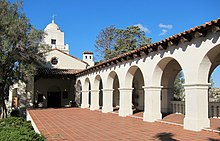
San Diego County has one of the highest counts of animal and plant species that appear on theendangered listof counties in the United States.[93]Because of its diversity of habitat and its position on thePacific Flyway,San Diego County has recorded 492 different bird species, more than any other region in the country.[94]San Diego always scores high in the number of bird species observed in the annualChristmas Bird Count,sponsored by theAudubon Society,and it is known as one of the "birdiest" areas in the United States.[95][96]
San Diego and its backcountry suffer from periodic wildfires. In October 2003, San Diego was the site of theCedar Fire,at that time the largest wildfire in California over the past century.[97]The fire burned 280,000 acres (1,100 km2), killed 15 people, and destroyed more than 2,200 homes.[98]In addition to damage caused by the fire, smoke resulted in a significant increase in emergency room visits due to asthma, respiratory problems, eye irritation, and smoke inhalation; the poor air quality caused San Diego County schools to close for a week.[99]Wildfires four years laterdestroyed some areas, particularly withinRancho Bernardo,as well as the nearby communities ofRancho Santa FeandRamona.[93]
Neighborhoods[edit]
The City of San Diego recognizes 52 individual areas as Community Planning Areas.[100]Within a given planning area there may be several distinct neighborhoods. Altogether the city contains more than 100 identifiedneighborhoods.
Downtown San Diegois located on San Diego Bay.Balboa Parkencompasses several mesas and canyons to the northeast, surrounded by older, dense urban communities includingHillcrestandNorth Park.To the east and southeast lieCity Heights,theCollege Area,andSoutheast San Diego.To the north liesMission ValleyandInterstate 8.The communities north of the valley and freeway, and south ofMarine Corps Air Station Miramar,includeClairemont,Kearny Mesa,Tierrasanta,andNavajo.Stretching north from Miramar are the northern suburbs ofMira Mesa,Scripps Ranch,Rancho Peñasquitos,andRancho Bernardo.The far northeast portion of the city encompassesLake Hodgesand theSan Pasqual Valley,which holds an agricultural preserve.Carmel ValleyandDel Mar Heightsoccupy the northwest corner of the city. To their south areTorrey Pines State Reserveand the business center of theGolden Triangle.Further south are the beach and coastal communities ofLa Jolla,Pacific Beach,Mission Beach,andOcean Beach.Point Lomaoccupies the peninsula acrossSan Diego Bayfrom downtown. The communities ofSouth San Diego(anExclave), such asSan YsidroandOtay Mesa,are located next to theMexico–United States border,and are physically separated from the rest of the city by the cities ofNational CityandChula Vista.A narrow strip of land at the bottom of San Diego Bay connects these southern neighborhoods with the rest of the city.[101]
- Selection ofneighborhoods in San Diego
For the most part, San Diego neighborhood boundaries tend to be understood by its residents based on geographical boundaries like canyons and street patterns.[102]The city recognized the importance of its neighborhoods when it organized its 2008 General Plan around the concept of a "City of Villages".[103]
Cityscape[edit]

San Diego was originally centered on theOld Towndistrict, but by the late 1860s the focus had shifted to the bayfront, in the belief that this new location would increase trade. As the "New Town" – present-day Downtown – waterfront location quickly developed, it eclipsed Old Town as the center of San Diego.[43]
The first skyscraper over 300 feet (91 m) in San Diego was theEl Cortez Hotel,built in 1927; it was the tallest building in the city until 1963.[104]As time went on, multiple buildings claimed the title of San Diego's tallest skyscraper, including the530 B StreetandSymphony Towers.Currently the tallest building in San Diego isOne America Plaza,standing 500 feet (150 m) tall, which was completed in 1991.[105]The downtown skyline contains nosupertallbuildings due to a regulation put in place by theFederal Aviation Administrationin the 1970s, which set a 500 feet (152 m) limit on the height of buildings within a one-mile (1.6 km) radius of theSan Diego International Airport.[106]An iconic description of the skyline includes its skyscrapers being compared to the tools of a toolbox.[107]
There areseveral new high-rises under construction,including two that exceed 400 feet (122 m) in height.
Demographics[edit]
| Census | Pop. | Note | %± |
|---|---|---|---|
| 1850 | 500 | — | |
| 1860 | 731 | 46.2% | |
| 1870 | 2,300 | 214.6% | |
| 1880 | 2,637 | 14.7% | |
| 1890 | 16,159 | 512.8% | |
| 1900 | 17,700 | 9.5% | |
| 1910 | 39,578 | 123.6% | |
| 1920 | 74,361 | 87.9% | |
| 1930 | 147,995 | 99.0% | |
| 1940 | 203,341 | 37.4% | |
| 1950 | 334,387 | 64.4% | |
| 1960 | 573,224 | 71.4% | |
| 1970 | 696,769 | 21.6% | |
| 1980 | 875,538 | 25.7% | |
| 1990 | 1,110,549 | 26.8% | |
| 2000 | 1,223,400 | 10.2% | |
| 2010 | 1,307,402 | 6.9% | |
| 2020 | 1,386,932 | 6.1% | |
| 2023 (est.) | 1,388,320 | [108] | 0.1% |
| Population History of Western U.S. Cities & Towns, 1850–1990[56] U.S. Decennial Census[109] 2010–2020[9] | |||
| Historical racial composition | 2020[110] | 2010[111] | 1990[112] | 1970[112] | 1940[112] |
|---|---|---|---|---|---|
| White(non-Hispanic) | 40.7% | 45.1% | 58.7% | 78.9%[a] | n/a |
| Hispanic or Latino(of any race) | 29.7% | 28.8% | 20.7% | 10.7%[a] | n/a |
| Asian(non-Hispanic) | 17.6% | 15.9% | 11.8% | 2.2% | 1.0% |
| Black or African American(non-Hispanic) | 6.6% | 6.7% | 9.4% | 7.6% | 2.0% |
2020[edit]
| Race / Ethnicity(NH = Non-Hispanic) | Pop 2000[113] | Pop 2010[114] | Pop 2020[115] | % 2000 | % 2010 | % 2020 |
|---|---|---|---|---|---|---|
| Whitealone (NH) | 603,892 | 589,702 | 565,128 | 49.36% | 45.10% | 40.75% |
| Black or African Americanalone (NH) | 92,830 | 82,497 | 77,542 | 7.59% | 6.31% | 5.59% |
| Native AmericanorAlaska Nativealone (NH) | 4,267 | 3,545 | 3,200 | 0.35% | 0.27% | 0.23% |
| Asianalone (NH) | 164,895 | 204,347 | 243,428 | 13.48% | 15.63% | 17.55% |
| Pacific Islanderalone (NH) | 5,311 | 5,178 | 4,887 | 0.43% | 0.40% | 0.35% |
| Other racealone (NH) | 3,065 | 3,293 | 8,208 | 0.25% | 0.25% | 0.59% |
| Mixed race or Multiracial(NH) | 38,388 | 42,820 | 73,243 | 3.14% | 3.28% | 5.28% |
| Hispanic or Latino(any race) | 310,752 | 376,020 | 411,286 | 25.40% | 28.76% | 29.65% |
| Total | 1,223,400 | 1,307,402 | 1,386,932 | 100.00% | 100.00% | 100.00% |
2010[edit]
The city had a population of 1,307,402 according to the 2010 census, distributed over a land area of 372.1 square miles (963.7 km2).[116]The urban area of San Diego had a total population of 2,956,746, making it thethird-largestin the state, after those ofLos AngelesandSan Francisco.
The 2010 population represented an increase of just under 7% from the 1,223,400 people reported in 2000.[111]The population density was 3,771.9 inhabitants per square mile (1,456.3/km2). The racial makeup of San Diego was 58.9%White,6.7% African American, 0.6% Native American, 15.9%Asian(5.9%Filipino,2.7%Chinese,2.5%Vietnamese,1.3%Indian,1.0%Korean,0.7%Japanese,0.4%Laotian,0.3%Cambodian,0.1%Thai). 0.5%Pacific Islander(0.2%Guamanian,0.1%Samoan,0.1%Native Hawaiian), 12.3% fromother races,and 5.1% from two or more races. 28.8% of the population wasHispanicorLatino(of any race);[111][117]24.9% of the total population was ofMexicanheritage, 1.4%Spanishand 0.6%Puerto Rican.The median age of Hispanic residents was 27.5 years, compared to 35.1 years overall and 41.6 years among non-Hispanic whites; Hispanic San Diegans were the largest group under the age of 18, while non-Hispanic whites constituted 63.1% of population 55 and older.

As of January 2019[update],the San Diego City and County had the fifth-largesthomelesspopulation among major cities in the United States, with 8,102 people experiencing homelessness.[118]In the city of San Diego, 4,887 individuals were experiencing homelessness according to the 2020 count.[119]A recent article from The San Diego Union-Tribune by Blake Nelson, published on December 11, 2023, reports a notable decline in the homeless population in downtown San Diego, specifically in the urban core. According to data from the Downtown San Diego Partnership, the number of individuals living outside or in vehicles has reached a two-year low, standing at approximately 1,200 as of last month. The decrease is attributed to the implementation of the city's camping ban and the concerted efforts to establish new shelters. While enforcement has led to relatively few individuals being punished, the threat of legal consequences appears to have played a role in the reduction.[120]
In 2000 there were 451,126 households, out of which 30.2% had children under the age of 18 living with them, 44.6% were married couples living together, 11.4% had a female householder with no husband present, and 39.8% were non-families. Households made up of individuals account for 28.0%, and 7.4% had someone living alone who was 65 years of age or older. The average household size was 2.61, and the average family size was 3.30.
The U.S. Census Bureau reported that in 2000, 24.0% of San Diego residents were under 18, and 10.5% were 65 and over.[111]As of 2011[update]the median age was 35.6; more than a quarter of residents were under age 20 and 11% were over age 65.[121]Millennials(ages 26 through 42) constitute 27.1% of San Diego's population, the second-highest percentage in a major U.S. city.[122]The San Diego County regional planning agency, SANDAG, provides tables and graphs breaking down the city population into five-year age groups.[123]

In 2000, themedian income for a householdin the city was $45,733, and the median income for a family was $53,060. Males had a median income of $36,984 versus $31,076 for females. The per capita income for the city was $35,199.[124]According toForbesin 2005, San Diego was the fifth wealthiest U.S. city,[125]but about 10.6% of families and 14.6% of the population were below the poverty line, including 20.0% of those under age 18 and 7.6% of those age 65 or over.[124]As of January 1, 2008, estimates by theSan Diego Association of Governmentsrevealed that the household median income for San Diego rose to $66,715, up from $45,733 in 2000.[126]
San Diego was named the ninth-mostLGBT-friendly city in the U.S. in 2013.[127]The city also has theseventh-highest populationof gay residents in the U.S. Additionally in 2013,San Diego State University(SDSU), one of the city's prominent universities, was named one of the top LGBT-friendly campuses in the nation.[128]
Religion[edit]
According to a 2014 study by thePew Research Center,68% of the population of the city identified themselves asChristians,with 32% professing adherence to variousProtestantchurches and 32% professingRoman Catholicbeliefs.[129][130]while 27% claimno religious affiliation.The same study found that followers of other religions (includingJudaism,Buddhism,Islam,andHinduism) collectively made up about 5% of the population.
Foreign-born population[edit]
The majority of San Diego's foreign-born population were born inMexico,thePhilippines,ChinaandVietnam.[131]
Economy[edit]


The largest sectors of San Diego's economy aredefense/military,tourism,international trade,andresearch/manufacturing.[132][133] San Diego recorded amedian household incomeof $79,646 in 2018, an increase of 3.89% from $76,662 in 2017.[134]The median property value in San Diego in 2018 was $654,700,[134]and the average home has two cars per household.[134]
Top employers[edit]
According to the city's 2022 Annual Comprehensive Financial Report,[135]the top employers in the city are:
| Employer | No.of Employees |
|---|---|
| Naval Base San Diego | 41,321 |
| University of California, San Diego | 37,064 |
| Sharp Health Care | 18,839 |
| County of San Diego | 16,744 |
| Scripps Health | 13,787 |
| San Diego Unified School District | 13,559 |
| Qualcomm, Inc. | 11,546 |
| City of San Diego | 11,466 |
| Kaiser Permanente | 9,632 |
| Northrop Grumman Corporation | 6,075 |
Defense and military[edit]

The economy of San Diego is influenced byits deepwater port,which includes the only major submarine and shipbuilding yards on theWest Coast.[136]Several major nationaldefense contractorswere started and are headquartered in San Diego, includingGeneral Atomics,Cubic,andNASSCO.[137][138]
San Diego hosts the largest naval fleet in the world:[139]In 2008 it was home to 53 ships, over 120 tenant commands, and more than 35,000 sailors, marines,Department of Defensecivilian employees and contractors.[140]About 5 percent of all civilian jobs in the county are military-related, and 15,000 businesses in San Diego County rely on Department of Defense contracts.[140]

Military bases in San Diego includeUS Navyfacilities,Marine Corpsbases, andCoast Guardstations. The city is "home to the majority of the U.S. Pacific Fleet's surface combatants, all of the Navy's West Coast amphibious ships and a variety of Coast Guard and Military Sealift Command vessels".[140][141]
The military infrastructure in San Diego is still growing and developing, with numerous military personnel stationed there, numbers of which are expected to rise. This plays a significant role in the city's economy, as of 2020[update],it provides roughly 25% of the GDP and provides 23% of the total jobs in San Diego.[142][143][144]
Tourism[edit]

Tourism is a major industry owing to the city's climate,beaches,[145]and tourist attractions such asBalboa Park,Belmontamusement park,San Diego Zoo,San Diego Zoo Safari Park,andSeaWorld San Diego.San Diego's Spanish and Mexican heritage is reflected in many historic sites across the city, such asMission San Diego de AlcaláandOld Town San Diego State Historic Park.Also, thelocal craft brewing industryattracts an increasing number of visitors[146]for "beer tours" and the annual San Diego Beer Week in November;[147]San Diego has been called "America's Craft Beer Capital".[148]
San Diego County hosted more than 32 million visitors in 2012; collectively they spent an estimated $8 billion. The visitor industry provides employment for more than 160,000 people.[149]
San Diego's cruise ship industry used to be the second-largest in California. Numerous cruise lines operate out of San Diego. However, cruise ship business has been in decline since 2008, when the Port hosted over 250 ship calls and more than 900,000 passengers. By 2016–2017, the number of ship calls had fallen to 90.[150]
Local sightseeing cruises are offered in San Diego Bay and Mission Bay, as well as whale-watching cruises to observe the migration ofgray whales,peaking in mid-January.[151]Sport fishingis another popular tourist attraction; San Diego is home to southern California's biggest sport fishing fleet.[152]
International trade[edit]

San Diego's commercial port and its location on theUnited States–Mexico bordermake international trade an important factor in the city's economy. The city is authorized by the United States government to operate as aForeign Trade Zone.[153]
The city shares a 15-mile (24 km) border with Mexico that includes two border crossings. San Diego hosts the busiest international border crossing in the world, in the San Ysidro neighborhood at theSan Ysidro Port of Entry.[154]A second, primarily commercial border crossing operates in theOtay Mesaarea; it is the largest commercial crossing on the California–Baja Californiaborder and handles the third-highest volume of trucks and dollar value of trade among all United States-Mexico land crossings.[155]

ThePort of San Diegois the third-busiest port in California and one of the busiest on theWest Coast.One of the Port of San Diego's twocargofacilities is located inDowntown San Diegoat the Tenth Avenue Marine Terminal. This terminal has facilities forcontainers,bulk cargo,andrefrigeratedand frozen storage, so that it can handle the import and export of many commodities.[156]In 2009 the Port of San Diego handled 1,137,054 short tons of total trade; foreign trade accounted for 956,637 short tons while domestic trade amounted to 180,417 short tons.[157]
Historically tuna fishing and canning was one of San Diego's major industries,[158]although the American tuna fishing fleet is no longer based in San Diego. Seafood companyBumble Bee Foodsis headquartered in San Diego, as wasChicken of the Seauntil 2018.[159][160]
Companies[edit]

San Diego hosts several major producers of wireless cellular technology.Qualcommwas founded and is headquartered in San Diego, and is one of the largest private-sector employers in San Diego.[161]Other wireless industry manufacturers headquartered here includeNokia,LG Electronics,[162]Kyocera International,[163]Cricket Communicationsand Novatel Wireless.[164]San Diego also has the U.S. headquarters for the Slovakian security companyESET.[165]San Diego has been designated as an iHub Innovation Center for potential collaboration between wireless and the life sciences.[166]
TheUniversity of California, San Diegoand other research institutions have helped to fuel the growth ofbiotechnology.[167]In 2013, San Diego had the second-largest biotech cluster in the United States, below theBoston areaand above theSan Francisco Bay Area.[168]There are more than 400 biotechnology companies in the area.[169]In particular, theLa Jollaand nearbySorrento Valleyareas are home to offices and research facilities for numerous biotechnology companies.[170]Major biotechnology companies likeIlluminaandNeurocrine Biosciencesare headquartered in San Diego, while many other biotech and pharmaceutical companies have offices or research facilities in San Diego. San Diego is also home to more than 140contract research organizations(CROs) that provide contract services for pharmaceutical and biotechnology companies.[171]
Real estate[edit]
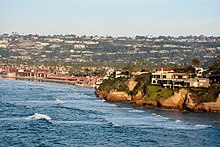
San Diego has high real estate prices. San Diego home prices peaked in 2005, and then declined along with the national trend. As of December 2010, prices were down 36 percent from the peak,[172]median price of homeshaving declined by more than $200,000 between 2005 and 2010.[173]As of May 2015, the median price of a house was $520,000.[174]In November 2018 the median home price was $558,000. The San Diego metropolitan area had one of the worst housing affordability rankings of all metropolitan areas in the United States in 2009.[175]The San Diego Housing Market experienced a decline in the median sold price of existing single-family homes between December 2022 and January 2023, with a 2.9% decrease from $850,000 to $824,950.[176]As of 2023, the majority of homes (nearly 60%) in San Diego are listed above $1 million, with the city's median home price at $910,000, ranking it fourth highest among the 30 largest U.S. cities.[177][178]
Consequently, San Diego has experienced negative net migration since 2004. A significant number of people have moved to adjacentRiverside County,commuting daily to jobs in San Diego, while others are leaving the area altogether and moving to more affordable regions.[179]
Government[edit]
Local government[edit]

The city is governed by a mayor and a nine-member city council. In 2006, its government changed from acouncil–manager governmentto astrong mayor government,as decided by a citywide vote in 2004. The mayor is in effect the chief executive officer of the city, while the council is the legislative body.[180]The City of San Diego is responsible forpolice,public safety, streets, water and sewer service, planning and zoning, and similar services within its borders. San Diego is asanctuary city,[181]however, San Diego County is a participant of theSecure Communitiesprogram.[182][183]As of 2011[update],the city had one employee for every 137 residents, with a payroll greater than $733 million.[184]
The members of the city council are each elected from single-member districts within the city. The mayor and city attorney are elected directly by the voters of the entire city. The mayor, city attorney, and council members are elected to four-year terms, with a two-term limit.[185]Elections are held on a non-partisan basis per California state law; nevertheless, most officeholders do identify themselves as either Democrats or Republicans. In 2007, registered Democrats outnumbered Republicans by about 7 to 6 in the city,[186]and Democrats currently (as of 2022[update]) hold an 8–1 majority in the city council. The current mayor,Todd Gloria,is a member of theDemocratic Party.

San Diego is part ofSan Diego County,and includes all or part of the 1st, 2nd, 3rd and 4th supervisorial districts of theSan Diego County Board of Supervisors,[187]Other county officers elected in part by city residents include theSheriff,District Attorney,Assessor/Recorder/County Clerk, and Treasurer/Tax Collector.
Areas of the city immediately adjacent toSan Diego Bay( "tidelands") are administered by thePort of San Diego,a quasi-governmental agency which owns all the property in the tidelands and is responsible for its land use planning, policing, and similar functions. San Diego is a member of the regional planning agencySan Diego Association of Governments(SANDAG). Public schools within the city are managed and funded by independent school districts (seebelow).
After narrowly supportingLyndon B. Johnsonin 1964, San Diego provided majorities to all six Republican presidential candidates from 1968 to 1988. However, in more recent decades, San Diego has trended in favor ofDemocraticpresidential candidates for president.George H. W. Bushin 1988 is the last Republican candidate to carry San Diego in a presidential election.
State and federal representation[edit]

In theCalifornia State Senate,San Diego County encompasses the38th,39thand40thdistricts,[188]represented byCatherine Blakespear(D),Toni Atkins(D), andBrian Jones(R), respectively.
In theCalifornia State Assembly,lying partially within the city of San Diego are the77th,78th,79th,and80thdistricts,[189]represented byTasha Boerner(D),Chris Ward(D),Akilah Weber(D), andDavid Alvarez(D), respectively.
In theUnited States House of Representatives,San Diego County includes parts or all of California's48th,49th,50th,51st,and52ndcongressional districts,[190]represented byDarrell Issa(R),Mike Levin(D),Scott Peters(D),Sara Jacobs(D), andJuan Vargas(D) respectively.
Scandals[edit]

San Diego was the site of the 1912San Diego free speech fight,in which the city restricted speech, vigilantes brutalized and tortured anarchists, and theSan Diego Police Departmentkilled a member of theIndustrial Workers of the World(IWW).
In 1916,rainmakerCharles Hatfieldwas blamed for $4 million in damages and accused of causing San Diego's worstflood,during which about 20Japanese Americanfarmers died.[191]
Then-mayorRoger Hedgecockwas forced to resign his post in 1985, after he was found guilty of one count ofconspiracyand 12 counts ofperjury,related to the alleged failure to report allcampaign contributions.[192][193]After a series of appeals, the 12 perjury counts were dismissed in 1990 based on claims ofjuror misconduct;the remaining conspiracy count was reduced to amisdemeanorand then dismissed.[194]
A 2002 scheme to underfund pensions for city employees led to theSan Diego pension scandal.This resulted in the resignation of newly re-elected MayorDick Murphy[195]and the criminal indictment of six pension board members.[196]Those charges were finally dismissed by a federal judge in 2010.[197]

On November 28, 2005, U.S. CongressmanRandy "Duke" Cunninghamresigned after being convicted on federalbriberycharges. He had representedCalifornia's 50th congressional district,which includes much of the northern portion of the city of San Diego. In 2006, Cunningham was sentenced to a 100-month prison sentence.[198]He was released in 2013.
In 2005 two city council members,Ralph Inzunzaand Deputy MayorMichael Zucchet– who briefly took over as acting mayor when Murphy resigned – were convicted ofextortion,wire fraud,andconspiracy to commit wire fraudfor taking campaign contributions from astrip clubowner and his associates, allegedly in exchange for trying to repeal the city's "no touch" laws at strip clubs.[199]Both subsequently resigned. Inzunza was sentenced to 21 months in prison.[200]In 2009, a judge acquitted Zucchet on seven out of the nine counts against him, and granted his petition for a new trial on the other two charges;[201]the remaining charges were eventually dropped.[202]
In July 2013, three former supporters of mayorBob Filnerasked him to resign because of allegations of repeatedsexual harassment.[203]Over the ensuing six weeks, 18 women came forward to publicly claim that Filner had sexually harassed them,[204]and multiple individuals and groups called for him to resign. Filner agreed to resign effective August 30, 2013, subsequently pleaded guilty to one felony count offalse imprisonmentand two misdemeanorbatterycharges, and was sentenced tohouse arrestandprobation.[205][206]
Crime[edit]

Like most major cities, San Diego had a declining crime rate from 1990 to 2000. 1991 would mark the city's deadliest year, registering 179 homicides[207]within city limits (while theregionas a whole peaked at 278 homicides),[208]capping off an unabated, eight-year climb in murders, rapes, robberies, and assault dating back to 1983. At the time, the city was ranked last among the 10 most populous U.S. cities in homicides per 1,000 population, and ninth in crimes per 1,000.[209]From 1980 to 1994, San Diego surpassed 100 murders ten times before tapering off to 91 homicides in 1995. That number would not exceed 79 for the next 15 years.[210]Crime in San Diego increased in the early 2000s.[211][212][213]In 2004, San Diego had the sixth lowest crime rate of any U.S. city with over half a million residents.[213]From 2002 to 2006, the crime rate overall dropped 0.8%, though not evenly by category. Whileviolent crimedecreased 12.4% during this period,property crimeincreased 1.1%. Total property crimes per 100,000 people were lower than the national average in 2008.[214]
According toUniform Crime Reportstatistics compiled by theFederal Bureau of Investigation(FBI) in 2010, there were 5,616 violent crimes and 30,753 property crimes. Of these, the violent crimes consisted of forcible rapes, 73 robberies and 170 aggravated assaults, while 6,387 burglaries, 17,977 larceny-thefts, 6,389 motor vehicle thefts and 155 acts of arson defined the property offenses.[215]In 2013, San Diego had the lowest murder rate of the ten largest cities in the United States.[216]
Education[edit]
Primary and secondary schools[edit]

Public schoolsin San Diego are operated by independentschool districts.The majority of the public schools in the city are served by theSan Diego Unified School District,the second-largest school district in California, which includes 11 K–8 schools, 107 elementary schools, 24 middle schools, 13 atypical and alternative schools, 28 high schools, and 45charter schools.[217]
Several adjacent school districts which are headquartered outside the city limits serve some schools within the city; these include thePoway Unified School District,Del Mar Union School District,San Dieguito Union High School District,andSweetwater Union High School District.In addition, there are a number of private schools in the city.
Colleges and universities[edit]

According to education rankings released by theU.S. Census Bureauin 2017, 44.4% of San Diegans (city, not county) ages 25 and older holdbachelor's degrees,compared to 30.9% in the United States as a whole. The census ranks the city as the ninth-most educated city in the United States, based on these figures.[218]
The largest university in the area is theUniversity of California, San Diego(UC San Diego). The university is the southernmost campus of theUniversity of Californiasystem and is the second largest employer in the city. It is the only university in the city that isclassified"R1: Doctoral Universities – Very high research activity", and it has the 7th largest research expenditure in the country.[219]
Other public colleges and universities in the city includeSan Diego State University(SDSU) and theSan Diego Community College District,which includesSan Diego City College,San Diego Mesa College,andSan Diego Miramar College.

Private non-profit colleges and universities in the city include theUniversity of San Diego(USD),Point Loma Nazarene University(PLNU),National University's San Diego campus,University of Redlands' School of Business San Diego campus,Brandman University's San Diego campus,San Diego Christian College,andJohn Paul the Great Catholic University.For-profit institutions includeAlliant International University(AIU),California International Business University(CIBU),California College San Diego,Fashion Institute of Design & Merchandising's San Diego campus,NewSchool of Architecture and Design,Platt College,Southern States University(SSU),UEI College,andWoodbury UniversitySchool of Architecture's satellite campus.
There is one medical school in the city, theUC San Diego School of Medicine.There are threeABAaccredited law schools in the city, which includeCalifornia Western School of Law,Thomas Jefferson School of Law,andUniversity of San Diego School of Law.There is also one law school,Western Sierra Law School,not accredited by the ABA.
Libraries[edit]

The city-runSan Diego Public Librarysystem is headquartered downtown and has 36 branches throughout the city.[220]The newest location is in Skyline Hills, which broke ground in 2015.[221]The libraries have had reduced operating hours since 2003 due to the city's financial problems. In 2006 the city increased spending on libraries by $2.1 million.[222]A new nine-story Central Library on Park Boulevard at J Street opened on September 30, 2013.[223]
In addition to the municipal public library system, there are nearly two dozen libraries open to the public run by other governmental agencies, and by schools, colleges, and universities.[224]Noteworthy are theMalcolm A. Love Libraryat San Diego State University, and theGeisel Libraryat theUniversity of California, San Diego.
Culture[edit]

The culture of San Diego, California is influenced heavily by the mi xing ofAmericanandMexican cultures,due to the city's position on theMexican-American border,its largeChicanopopulation, and its history as part ofHispanic AmericaandMexico.San Diego's longtime association with theU.S. militaryalso contributes to its culture.
Many popular museums, such as theSan Diego Museum of Art,theSan Diego Natural History Museum,theMuseum of Us,theMuseum of Photographic Arts,and theSan Diego Air & Space Museum,are located in Balboa Park, which is also the location of theSan Diego Zoo.TheMuseum of Contemporary Art San Diego(MCASD) is located in La Jolla and has a branch located at theSanta Fe Depotdowntown. The downtown branch consists of two buildings on two opposite streets.

TheColumbia districtdowntown is home to historic ship exhibits belonging to theSan Diego Maritime Museum,headlined by theStar of India,as well as the unrelatedSan Diego Aircraft Carrier Museumfeaturing theUSSMidwayaircraft carrier.
TheSan Diego SymphonyatSymphony Towersperforms on a regular basis; from 2004 to 2017, its director wasJahja Ling.TheSan Diego Operaat Civic Center Plaza, directed by David Bennett.Old Globe Theatreat Balboa Park produces about 15 plays and musicals annually. TheLa Jolla Playhouseat UCSD is directed byChristopher Ashley.Both the Old Globe Theatre and the La Jolla Playhouse have produced the world premieres of plays and musicals that have gone on to winTony Awards[225]or nominations[226]onBroadway.TheJoan B. KrocTheatre at Kroc Center's Performing Arts Center is a 600-seat state-of-the-art theater that hosts music, dance, and theater performances. TheSan Diego Repertory Theatreat the Lyceum Theatres inWestfield Horton Plazaproduces a variety of plays and musicals. Hundreds of movies and a dozen TV shows have beenfilmed in San Diego,a tradition going back as far as 1898.[227]
Sports[edit]
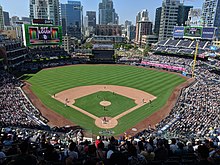
Sports in San Diego includesmajor professional leagueteams, otherhighest-level professional leagueteams,minor leagueteams, andcollege athletics.TheSan Diego Padrescompete inMajor League Baseball(MLB).San Diego FCbegins play inMajor League Soccer(MLS) in 2025.[228]TheSan Diego State Aztecscompete inNCAA Division I(FBS). TheFarmers Insurance Open,a professionalgolftournament on thePGA Tour,is played annually atTorrey Pines Golf Course.
Professional teams[edit]
The following teams compete at their sport's highest level of domestic competition.
- Boldindicatesmajor professional leagueteam.
- Italicindicatescluborsemi-proteam competing in its sport's highest level league, where the sport has no fully-professional domestic competition.
Minor league teams[edit]
The following teams compete below their sport's highest level of domestic competition.
| Club | League | Sport | Home venue | Since[k] | Attendance[l] |
|---|---|---|---|---|---|
| San Diego Gulls | AHL | Ice hockey | Pechanga Arena | 1966;[m]2015[n] | 7,249(2023-24)[234] |
| San Diego Clippers | G League | Basketball | Frontwave Arena | 2024[235] | |
| San Diego Surf Riders | MiLC | Cricket | Canyonside Park | 2021 |
College teams[edit]
| Club | University | League | Primary conference | Enrollment |
|---|---|---|---|---|
| San Diego State Aztecs | San Diego State University | NCAA Division I(FBS) | Mountain West Conference | 35,723[236](2022) |
| San Diego Toreros | University of San Diego | NCAA Division I(FCS) | West Coast Conference | 8,815[237](2022) |
| UC San Diego Tritons | University of California, San Diego | NCAA Division I | Big West Conference | 42,968[238](2022) |
| Cal State San Marcos Cougars | California State University, San Marcos | NCAA Division II | California Collegiate Athletic Association | 14,311[239](2022) |
| Point Loma Sea Lions | Point Loma Nazarene University | NCAA Division II | Pacific West Conference | 3,179[240](2021) |
Annual events[edit]

| Event | League | Sport | Venue | Since |
|---|---|---|---|---|
| Farmers Insurance Open | PGA Tour | Golf | Torrey Pines Golf Course | 1952 |
| Holiday Bowl | NCAA Division I(FBS) | Football | Snapdragon Stadium | 1978 |
| Rady Children's Invitational | NCAA Division I | Basketball | LionTree Arena | 2023 |
| San Diego Open | WTA Tour | Tennis | Barnes Tennis Center | 1984 |
| San Diego Bayfair Cup | H1 Unlimited | Hydroplane racing | Mission Bay | 1964 |
| Rock 'n' Roll San Diego Marathon | Rock 'n' Roll Running Series | Running | San Diego | 1998 |
Media[edit]

Published within the city are the daily newspaper,The San Diego Union Tribuneand its online portal of the same name,[241]and the alternative newsweeklies, theSan Diego CityBeatandSan Diego Reader.Times of San Diegois a free online newspaper covering news in the metropolitan area.Voice of San Diegois a non-profit online news outlet covering government, politics, education, neighborhoods, and the arts. TheSan Diego Daily Transcriptis a business-oriented online newspaper.
San Diego is also the headquarters of the nationalfar-rightcable TV channelOne America News Network (OANN),which was founded in 2013 and is owned byHerring Networks.The network gained notoriety for being ardent supporters ofDonald Trumpand providing a platform forright-wingconspiracy theories.
San Diego led U.S. local markets with 69.6 percent broadband penetration in 2004 according toNielsen//NetRatings.[242]
San Diego's first television station wasKFMB,which began broadcasting on May 16, 1949.[243]Since theFederal Communications Commission(FCC) licensed seven television stations in Los Angeles, twoVHFchannels were available for San Diego because of its relative proximity to the larger city. In 1952, however, the FCC began licensingUHFchannels, making it possible for cities such as San Diego to acquire more stations. Stations based in Mexico (withITU prefixesof XE and XH) also serve the San Diego market. Television stations today includeXHCPDE11 (Canal Once (Mexico)),XETV6 (Canal 5/Nueve),KFMB8 (CBS,withThe CW/MNTVon DT2),KGTV10 (ABC),XEWT12 (Televisa Regional),KPBS15 (PBS),KBNT-CD17 (Univision),XHTIT-TDT21 (Azteca 7),XHJK-TDT1 (Azteca Uno),XHAS33 (Canal 66),K35DG-D35 (UCSD-TV),KDTF-LD36 (Unimás),KNSD39 (NBC),KUAN-LD48 (Telemundo),KSEX-CD42 (Infomercials),XHBJ-TDT45 (Canal 6 (Mexico)),XHDTV49 (Milenio Televisión),KUSI51 (Independent),XHUAA-TDT19 (Canal de las Estrellas), andKSWB-TV69 (Fox). San Diego has an 80.6 percent cable penetration rate.[244]

Due to the ratio of U.S. and Mexican-licensed stations, San Diego is the largestmedia marketin the United States that is legally unable to support atelevision station duopolybetween two full-power stations underFCCregulations, which disallow duopolies in metropolitan areas with fewer than nine full-power television stations and require that there would be eight unique station owners that remain once a duopoly is formed (there are only seven full-power stations on the California side of the San Diego-Tijuana market).[245]Though theE. W. Scripps Companyowns KGTV and KZSD-LP, they are not considered a duopoly under the FCC's legal definition as common ownership between full-power andlow-powertelevision stations in the same market is permitted regardless of the number of stations licensed to the area. As a whole, the Mexico side of the San Diego-Tijuana market has two duopolies and one triopoly (Entravision Communicationsowns bothXHAS-TVand XHDTV-TV,AztecaownsXHJK-TVandXHTIT-TV,andGrupo TelevisaownsXHUAA-TVandXEWT-TValong with being the license holder for XETV-TV, which was formerly managed by California-based subsidiaryBay City Television).
San Diego's television market is limited to onlySan Diego County.TheImperial Valley,includingEl Centro,is in theYuma, Arizonatelevision market while neighboringOrangeandRiversidecounties are part of the Los Angeles market. (Sometimes, in the past, a missing network affiliate in the Imperial Valley would be available on cable TV from San Diego.) As a result, San Diego is the largest single-county media market in the United States.
The radio stations in San Diego include nationwide broadcasteriHeartMedia;Entercom Communications,Local Media San Diego, and many other smaller stations and networks. Stations include:KOGO AM 600,KGB AM 760,KCEO AM 1000,KCBQ AM 1170,K-Praise,KLSD AM 1360,KFSD 1450 AM,KPBS-FM89.5,Channel 933,Star 94.1,FM 94/9,FM News and Talk 95.7,Q9696.1,KyXy96.5,Free Radio San Diego(AKAPirate RadioSan Diego) 96.9FM FRSD,KWFN97.3,KXSN98.1,Big-FM 100.7,101.5KGB-FM,KLVJ102.1,KSON103.7,Rock 105.3,and anotherPirate Radiostation at 106.9FM, as well as a number of local Spanish-language radio stations.
Infrastructure[edit]
Transportation[edit]

With the automobile being the primary means of transportation for over 80 percent of residents, San Diego is served by a network of freeways and highways. This includesInterstate 5,which runs south toTijuanaand north to Los Angeles;Interstate 8,which runs east toImperial Countyand theArizona Sun Corridor;Interstate 15, which runs northeast through theInland EmpiretoLas VegasandSalt Lake City;andInterstate 805,which splits from I-5 near the Mexican border and rejoins I-5 atSorrento Valley.
Major state highways includeSR 94,which connects downtown with I-805, I-15 andEast County;SR 163,which connects downtown with the northeast part of the city, intersects I-805 and merges with I-15 atMiramar;SR 52,which connects La Jolla withEast CountythroughSanteeandSR 125;SR 56,which connects I-5 with I-15 throughCarmel ValleyandRancho Peñasquitos;SR 75,which spansSan Diego Bayas theSan Diego-Coronado Bridge,and also passes throughSouth San Diegoas Palm Avenue; andSR 905,which connects I-5 and I-805 to theOtay Mesa Port of Entry.

The stretch of SR 163 that passes through Balboa Park is San Diego's oldest freeway, dating back to 1948 when it was part ofUS 80andUS 395.It has been called one of America's most beautiful parkways.[246]
San Diego's roadway system provides an extensive network of cycle routes. Its dry and mild climate makes cycling a convenient year-round option; however, the city's hilly terrain and long average trip distances make cycling less practicable. Older and denser neighborhoods around the downtown tend to be oriented toutility cycling.This is partly because the grid street patterns are now absent in newer developments farther from the urban core, where suburban-style arterial roads are much more common. As a result, the majority of cycling is recreational.

San Diego is served by theSan Diego Trolleylight rail system,[247]by theSDMTS bus system,[248]privatejitneysin some neighborhoods,[249]and byCoaster[250]andAmtrak Pacific Surfliner[251]commuter rail; northernSan Diego countyis also served by theSprinterhybrid rail service.[252]The trolley primarily serves downtown and surrounding urban communities,Mission Valley,east county, and coastal south bay. A mid-coast extension of the Trolley operates fromOld TowntoUniversity Cityand theUniversity of California, San Diegoalong the I-5 Freeway since November 2021. The Amtrak and Coaster trains currently run along the coastline and connect San Diego with Los Angeles, Orange County, Riverside, San Bernardino, and Ventura viaMetrolinkand the Pacific Surfliner. There are two Amtrak stations in San Diego, inOld Townandthe Santa Fe Depotdowntown. San Diego transit information about public transportation and commuting is available on the Web and by dialing "511"from any phone in the area.[253]
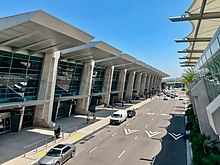
The city has two major commercial airports within or near its city limits.San Diego International Airport(SAN) is the busiest single-runway airport in the United States.[254][255]It served over 24 million passengers in 2018 and is dealing with larger numbers every year.[256]It is located on San Diego Bay, three miles (4.8 km) from downtown, and maintains scheduled flights to the rest of the United States (including Hawaii), as well as to Canada, Germany, Mexico, Japan, and the United Kingdom. It is operated by an independent agency, the San Diego Regional Airport Authority.Tijuana International Airporthas a terminal within the city limits in theOtay Mesadistrict connected to the rest of the airport inTijuana,Mexico,via theCross Border Xpresscross-border footbridge. It is the primary airport for flights to the rest of Mexico, and offers connections via Mexico City to the rest of Latin America. In addition, the city has two general-aviation airports,Montgomery Field(MYF) andBrown Field(SDM).[257]

Recent regional transportation projects have sought to mitigate congestion, including improvements to local freeways, expansion of San Diego Airport, and doubling the capacity of the cruise ship terminal. Freeway projects included expansion of Interstates 5 and 805 around "The Merge" where these two freeways meet, as well as expansion of Interstate 15 through North County, which includes newhigh-occupancy-vehicle (HOV) "managed lanes".A tollway (the southern portion of SR 125, known as the South Bay Expressway) connects SR 54 and Otay Mesa, near the Mexican border. According to an assessment in 2007, 37 percent of city streets were in acceptable condition. However, the proposed budget fell $84.6 million short of bringing streets up to an acceptable level.[258]Expansion at the port has included a second cruise terminal onBroadway Pier,opened in 2010. Airport projects include the expansion of Terminal Two.[259]
Utilities[edit]
Water is supplied to residents by the Water Department of the City of San Diego. The city receives most of its water from theMetropolitan Water District of Southern California,which brings water to the region from the Sacramento and San Joaquin rivers, via the state project and the Colorado River, via the Colorado Aqueduct.[260]
Gas and electric utilities are provided bySan Diego Gas & Electric,a division ofSempra Energy.[further explanation needed]The company provides energy service to 3.7 million people through 1.5 million electric meters and 900,000 natural gas meters in San Diego and southern Orange counties.[261]
Street lights[edit]
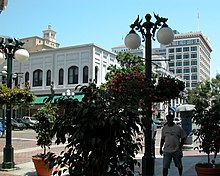
In the mid-20th century the city hadmercury vaporstreet lamps. In 1978, the city decided to replace them with more efficientsodium vaporlamps. This triggered an outcry fromastronomersatPalomar Observatory60 miles (100 km) north of the city, concerned that the new lamps would increaselight pollutionand hinder astronomical observation.[262]The city altered its lighting regulations to limit light pollution within 30 miles (50 km) of Palomar.[263]
In 2011, the city announced plans to upgrade 80% of its street lighting to new energy-efficient lights that useinduction technology,a modified form offluorescent lampproducing a broader spectrum than sodium vapor lamps. The new system is predicted to save $2.2 million per year in energy and maintenance.[264]The city stated the changes would "make our neighborhoods safer."[264]They also increaselight pollution.[265]
In 2014, San Diego announced plans to become the first U.S. city to install cyber-controlled street lighting, using an "intelligent" lighting system to control 3,000LEDstreet lights.[266]
Notable people[edit]
Sister cities[edit]
San Diego'ssister citiesare:[267]
 Alcalá de Henares,Spain (est. 1982)
Alcalá de Henares,Spain (est. 1982) Campinas,Brazil (est. 1995)
Campinas,Brazil (est. 1995) Cavite City,Philippines (est. 1969)
Cavite City,Philippines (est. 1969) Edinburgh,Scotland (est. 1977)
Edinburgh,Scotland (est. 1977) Jalalabad,Afghanistan (est. 2004)
Jalalabad,Afghanistan (est. 2004) Jeonju,South Korea (est. 1983)
Jeonju,South Korea (est. 1983) León,Mexico (est. 1969)
León,Mexico (est. 1969) Panama City,Panama (est. 2015)
Panama City,Panama (est. 2015) Perth,Australia (est. 1986)
Perth,Australia (est. 1986) Taichung,Taiwan (est. 1983)
Taichung,Taiwan (est. 1983) Tema,Ghana (est. 1976)
Tema,Ghana (est. 1976) Tijuana,Mexico (est. 1993)
Tijuana,Mexico (est. 1993) Vladivostok,Russia (est. 1991)
Vladivostok,Russia (est. 1991) Warsaw,Poland (est. 1996)
Warsaw,Poland (est. 1996) Yantai,China (est. 1985)
Yantai,China (est. 1985) Yokohama,Japan (est. 1957)
Yokohama,Japan (est. 1957)
See also[edit]
- USSSan Diego,4 ships
Notes[edit]
- ^First season in San Diego
- ^Average home game attendance
- ^Original founding as aMinor League Baseball(MiLB) team:San Diego Padres (PCL)
- ^Team was temporarily dormant for 2021 season due to effects ofCOVID-19 pandemic
- ^Original founding. Current team is the 3rd San Diego Sockers iteration of highest-level professional indoor soccer, revived in 2009. Previous teams:San Diego Sockers (1978–1996)andSan Diego Sockers (2001–2004)
- ^Sockers franchise includes titles won by its original iteration,San Diego Sockers (1978–1996),in preceding top professional indoor soccer leagues. The franchise's titles by league are as follows:
MASL:6 (2010,2011,2012,2013,2021,2022)
MISL:8 (1983,1985,1986,1988,1989,1990,1991,1992)
NASL Indoor:2 (1982,1984) - ^Team began play in 2019 as Redwoods Lacrosse Club, a charter member of the PLL, which was a touring-only league of nomadic teams for its first five seasons. The league assigned teams to home markets beginning in 2024, with San Diego's Torero Stadium becoming the home of the Redwoods
- ^2001, 2006
- ^Non-annual competition, no fixed schedule- matches held years apart on dates agreed upon between the defender and the challenger
- ^1987,1988,1992
- ^First season in San Diego
- ^Average home game attendance
- ^Original founding. Current team is the 4th San Diego Gulls iteration of minor league professional ice hockey, revived in 2015. Previous teams:San Diego Gulls (1966–1974),San Diego Gulls (1990–1995)&San Diego Gulls (1995–2006)
- ^Current AHL franchise was founded in 2000 as theNorfolk Admirals,later relocating to San Diego and assuming the Gulls name in 2015
References[edit]
- ^"WHO DECIDED...?:... To name San Diego 'America's Finest City'?".Los Angeles Times.December 25, 1985.
- ^"California City Nicknames List".seecalifornia.RetrievedDecember 29,2020.
- ^"California Cities by Incorporation Date".California Association ofLocal Agency Formation Commissions.Archived fromthe original(Word)on November 3, 2014.RetrievedAugust 25,2014.
- ^"City of San Diego City Charter, Article XV"(PDF).City of San Diego.RetrievedNovember 5,2014.
- ^"Office of the City Attorney".The City of San Diego. November 6, 2015.RetrievedDecember 14,2016.
- ^"City Council Offices".City of San Diego.RetrievedDecember 10,2014.
- ^"2019 U.S. Gazetteer Files".United States Census Bureau.RetrievedJuly 1,2020.
- ^ab"San Diego: Geography and Climate".city-data.RetrievedOctober 16,2014.
- ^abc"QuickFacts: San Diego city, California".census.gov.United States Census Bureau.RetrievedJanuary 22,2023.
- ^"List of 2020 Census Urban Areas".census.gov.United States Census Bureau.RetrievedJanuary 8,2023.
- ^"2020 Population and Housing State Data".United States Census Bureau.RetrievedAugust 22,2021.
- ^"Total Gross Domestic Product for San Diego-Carlsbad, CA (MSA)".U.S. Bureau of Economic Analysis.
- ^"ZIP code(tm) Lookup".United States Postal Service.RetrievedNovember 19,2014.
- ^"City of San Diego".Geographic Names Information System.United States Geological Survey,United States Department of the Interior.RetrievedOctober 16,2014.
- ^"QuickFacts: San Diego County, California".census.gov.United States Census Bureau.RetrievedJanuary 22,2023.
- ^McGrew, Clarence Alan (1922).City of San Diego and San Diego County: the birthplace of California.American Historical Society.RetrievedJuly 23,2011.
- ^Ayling, Marko (December 30, 2022)."San Diego and Tijuana: a vanishing border?".Mexico News Daily.RetrievedApril 30,2024.
- ^"San Diego Int'l Airport will dig up the runway every night for a year".San Diego Union-Tribune.November 20, 2017.RetrievedJanuary 26,2021.
- ^abMills, James (October 1967)."San Diego...Where California Began".Journal of San Diego History.13(4). Archived fromthe originalon June 14, 2011.RetrievedFebruary 17,2017.
- ^abcdMogilner, Geoffrey."Cosoy: Birthplace of New California".San Diego History Center | San Diego, CA | Our City, Our Story.RetrievedAugust 27,2020.
- ^"San Diego in Kumiai - English-Kumiai Dictionary | Glosbe".glosbe.RetrievedNovember 17,2023.
- ^"Pushuyi in Spanish - Luiseno-Spanish Dictionary | Glosbe".glosbe.RetrievedNovember 17,2023.
- ^Catalysts to complexity: late Holocene societies of the California coast.Los Angeles: Cotsen Institute of Archaeology at UCLA. 2002. p. 30.ISBN978-1-938770-67-8.OCLC745176510.
- ^High, Gary and Jerri-Ann Jacobs High Tech (2007).San Diego Bay: A Story of Exploitation and Restoration.California Sea Grant College Program.ISBN978-1-888691-17-7.
The Kumeyaay could have derived from the San Dieguito or they may have arrived from the desert around 1000 C.E.
- ^abLoveless, R.; Linton, B. (2020). "Culturally Sensitive and Scientifically Sound".Ethical approaches to human remains: a global challenge in bioarchaeology and forensic anthropology.Kirsty Squires, David Errickson, Nicholas Márquez-Grant. Cham, Switzerland: Springer Nature. pp. 419–420.ISBN978-3-030-32926-6.OCLC1135205590.
He created a sequence of cultural periods... the San Dieguito Complex and La Jolla Complex... suggested that... [they were] mutually exclusive and not associated with the ancestral populations of the contemporary Kumeyaay. The problem with Rogers' hypothesis is that it did not account for cultural evolution... Rogers' theories were, and continue to be, a popular paradigm... At the end of his career, Rogers re-evaluated his original conclusions regarding the cultural groups he had established...
- ^ab"Kosa'aay (Cosoy) History".cosoy.org.Archived fromthe originalon March 5, 2016.RetrievedAugust 27,2020.
- ^"San Diego Historical Society".Sandiegohistory.org. Archived fromthe originalon May 5, 2009.RetrievedMarch 12,2011.
- ^Pourade, Richard F. 1960.The History of San Diego: The Explorers.Union-Tribune Publishing Company, San Diego.
- ^Ide, Arthur Frederick (Fall 1976)."San Diego: The Saint and the City".Journal of San Diego History.22(4).
- ^"San Diego Historical Society:Timeline of San Diego history".Sandiegohistory.org. Archived fromthe originalon December 24, 2015.RetrievedMay 4,2011.
- ^Carrico, Richard."Sociopolitical Aspects of the 1775 Revolt at Mission San Diego de Alcala".San Diego History Center | San Diego, CA | Our City, Our Story.RetrievedAugust 27,2020.
- ^"Keyfacts".missionscalifornia. Archived fromthe originalon June 10, 2010.RetrievedJuly 1,2010.
- ^"Mission San Diego".Mission San Diego.RetrievedJuly 1,2010.
- ^"National Park Service, National Historical Landmarks Program: San Diego Presidio".Tps.cr.nps.gov. October 10, 1960. Archived fromthe originalon July 21, 2011.RetrievedMay 4,2011.
- ^"Timeline of San Diego History | San Diego History Center".December 24, 2015. Archived fromthe originalon December 24, 2015.RetrievedAugust 7,2018.
- ^Connolly, Mike."Kumeyaay – The Mexican Period".kumeyaay.
- ^Bean, Walton (1973).California: An Interpretive History(Second ed.). New York: McGraw-Hill, Inc. pp.74–76.ISBN978-0-07-004224-7.
- ^Griswold del Castillo, Richard (Winter 2003)."The U.S.-Mexican War in San Diego, 1846–1847".San Diego Historical Society Quarterly.
- ^Griswold de Castillo 1990,p. 39
- ^"A History of San Diego Government".Office of the City Clerk.City of San Diego. Archived fromthe originalon May 5, 2014.RetrievedMay 27,2014.
- ^"City of San Diego website".Sandiego.gov. Archived fromthe originalon October 11, 2007.RetrievedJuly 1,2010.
- ^Basil C. Pearce,"The Jackass Mail—San Antonio and San Diego Mail Line",San Diego Historical Society Quarterly,Spring 1969, Volume 15, Number 2
- ^abEngstrand 2005,p. 80
- ^Hall, Matthew T. (February 8, 2012)."100 years ago, San Diego banned free speech".San Diego Union-Tribune.RetrievedJuly 9,2021.
- ^Dotinga, Randy (March 15, 2011)."When San Diego Had Its Own Big Labor Clash".Voice of San Diego.RetrievedJuly 9,2021.
- ^Waller, Tom (April 2, 1992)."The Wobblies and San Diego's shame | San Diego Reader".San Diego Reader.RetrievedJuly 9,2021.
- ^"Shady Ladies in the" Stingaree District "When The Red Lights Went Out in San Diego".San Diego History Center. Archived fromthe originalon October 24, 2005.RetrievedMarch 8,2011.
- ^"Balboa Park future is full of repair jobs".The San Diego Union-Tribune.March 18, 2015. Archived fromthe originalon March 18, 2015.RetrievedAugust 7,2018.
- ^Marjorie Betts Shaw."The San Diego Zoological Garden: A Foundation to Build on".Journal of San Diego History.24(3, Summer 1978).RetrievedMay 4,2011.
- ^"CHAPTER 5: A Fiesta – Re-living the Days of the Dons | San Diego History Center".March 4, 2016. Archived fromthe originalon March 4, 2016.RetrievedAugust 7,2018.
- ^Perry, Tony (March 5, 2014)."Balboa Park centennial event organizers end efforts".Los Angeles Times.RetrievedApril 8,2014.
- ^"Historic California Posts: Fort Rosecrans".California State Military Museum.Archived fromthe originalon July 14, 2007.RetrievedNovember 26,2012.
- ^University of San Diego: Military Bases in San DiegoArchivedApril 11, 2007, at theWayback Machine
- ^abGerald A. Shepherd."When the Lone Eagle returned to San Diego".Journal of San Diego History.40(s. 1 and 2, Winter 1992).RetrievedMay 4,2011.
- ^"Consolidated Aircraft/Convair Online Exhibition".San Diego Air & Space Museum.RetrievedSeptember 22,2014.
- ^abMoffatt, Riley.Population History of Western U.S. Cities & Towns, 1850–1990.Lanham: Scarecrow, 1996, 54.
- ^Naomi Baumslag,Murderous Medicine: Nazi Doctors, Human Experimentation, and Typhus,2005, p.207
- ^Amy Stewart (April 25, 2011)."Where To Find The World's Most 'Wicked Bugs': Fleas".National Public Radio.
- ^Russell Working (June 5, 2001)."The trial of Unit 731".The Japan Times.
- ^"Milken Institute".Milken Institute.RetrievedJuly 1,2010.
- ^"San Diego History Center Honors San Diego's Tuna Fishing Industry at Annual Gala".San Diego History Center.RetrievedSeptember 1,2012.
- ^Felando, August & Medina, Harold (Winter–Spring 2012). "The Origins of California's High-Seas Tuna Fleet".The Journal of San Diego History.58(1 & 2): 5–8, 18.ISSN0022-4383.
- ^Lechowitzky, Irene (November 19, 2006)."It's the old country, with new condos".Los Angeles Times.RetrievedSeptember 1,2012.
- ^Crawford, Richard (June 20, 2009)."San Diego once was 'Tuna Capital of World'".San Diego Union Tribune.RetrievedSeptember 1,2012.[permanent dead link]
- ^Erie, Steven P.; Kogan, Vladimir; MacKenzi, Scott A. (May 2010). "Redevelopment, San Diego Style: The Limits of Public–Private Partnerships".Urban Affairs Review.45(5): 644–678.doi:10.1177/1078087409359760.S2CID154024558.
- ^Marshall, Monte."The Geology and Tectonic Setting of San Diego Bay, and That of the Peninsular Ranges and Salton Trough, Southern California".Phil Farquharson.RetrievedJuly 13,2012.
- ^"Canyon Enhancement Planning Guide"(PDF).San Diego Canyonlands. p. 7. Archived fromthe original(PDF)on June 20, 2013.RetrievedJuly 20,2012.
- ^Schad, Jerry (March 12, 2010).Afoot and Afield in San Diego.Wilderness Press, Berkeley, Calif. p. 111.ISBN9780899975153.RetrievedMay 4,2011.
- ^ab"Expeditions by Sea"The Explorers.Trans. Richard F. Pourade. La Jolla: Copley, 1960. 64–72.
- ^Janet R. Fireman and Manuel P. Servín, "Miguel Costansó: California's Forgotten Founder."California Historical Society Quarterly,vol. 49, no. 1, March 1970, pp. 3–19.
- ^"NOAA NCEI U.S. Climate Normals Quick Access".
- ^M. Kottek; J. Grieser; C. Beck; B. Rudolf; F. Rubel (2006)."World Map of the Köppen-Geiger climate classification updated"(PDF).Meteorol. Z.15(3): 259–263.Bibcode:2006MetZe..15..259K.doi:10.1127/0941-2948/2006/0130.RetrievedJuly 9,2013.
- ^"Atlas of the Biodiversity of California"(PDF).March 31, 2010. Archived fromthe original(PDF)on March 31, 2010.RetrievedAugust 7,2018.
- ^Francisco Pugnaire and Fernando Valladares eds.Functional Plant Ecology.2d ed. 2007. p.287.
- ^Michael Allaby, Martyn Bramwell, Jamie Stokes, eds.Weather and Climate: An Illustrated Guide to Science.2006. p.182.
- ^Michalski, Greg et al.First Measurements and Modeling of ∆17O in atmospheric nitrateArchivedJuly 24, 2013, at theWayback Machine.Geophysical Research Letters, Vol. 30, No. 16. p.3. 2003.
- ^"UCSD".Meteora.ucsd.edu. May 14, 2010. Archived fromthe originalon June 13, 2010.RetrievedJuly 1,2010.
- ^"Monthly Averages for San Diego, CA".The Weather Channel.Archived fromthe originalon May 2, 2009.RetrievedApril 22,2009.
- ^"Monthly Averages for El Cajon, CA".The Weather Channel.Archived fromthe originalon June 4, 2011.RetrievedApril 22,2009.
- ^Lee, Mike (June 18, 2011)."Is global warming changing California Current?".U-T (San Diego Union Tribune).RetrievedJune 20,2011.
- ^"San Diego's average rainfall set to lower level".San Diego Union-Tribune.March 16, 2011.RetrievedApril 12,2011.
- ^Rowe, Peter (December 13, 2007)."The day it snowed in San Diego".San Diego Union Tribune.Archived fromthe originalon August 10, 2011.RetrievedMay 4,2011.
- ^"Storm brings major snowfall to East County communities".Fox 5.Fox 5 Digital Team. February 21, 2019.RetrievedFebruary 27,2021.
- ^Conner, Glen.History of weather observations San Diego, California 1849–1948.Climate Database Modernization Program, NOAA's National Climatic Data Center. pp. 7–8.
- ^"NowData – NOAA Online Weather Data".National Oceanic and Atmospheric Administration.RetrievedJune 14,2021.
- ^"Summary of Monthly Normals 1991–2020".National Oceanic and Atmospheric Administration. Archived fromthe originalon August 8, 2023.RetrievedJune 14,2021.
- ^"San Diego/Lindbergh Field CA Climate Normals 1961–1990".National Oceanic and Atmospheric Administration. Archived fromthe originalon August 8, 2023.RetrievedJuly 18,2020.
- ^Pryde, Philip R. 2014. "The Nature of the County: San Diego's Climate, Vegetation, and Wildlife". In:San Diego: An Introduction to the Region,by Philip R. Pryde, pp. 29–45. 5th ed. Sunbelt Publications, San Diego.
- ^Wells, Michael L.; O'Leary, John F.; Franklin, Janet; Michaelsen, Joel; McKinsey, David E. (November 2, 2004). "Variations in a regional fire regime related to vegetation type in San Diego County, California (USA)".Landscape Ecology.19(2): 139–152.Bibcode:2004LaEco..19..139W.doi:10.1023/B:LAND.0000021713.81489.a7.S2CID40769609.1572-9761.
- ^Strömberg, Nicklas; Hogan, Michael (November 29, 2008)."Torrey Pine: Pinus torreyana".GlobalTwitcher. Archived fromthe originalon January 16, 2009.RetrievedApril 22,2009.
- ^"Tecolote Canyon Natural Park & Nature Center".The City of San Diego.RetrievedApril 22,2009.
- ^"Marian Bear Memorial Park".The City of San Diego. Archived fromthe originalon May 5, 2013.RetrievedApril 22,2009.
- ^ab"SignOnSanDiego > News > Politics – White House seeks limits to species act".October 21, 2012. Archived fromthe originalon October 21, 2012.RetrievedAugust 7,2018.
- ^"San Diego County Bird Atlas Project".San Diego Natural History Museum.RetrievedJune 20,2014.
- ^"Corpus Christi Recognized as Birdiest City".Corpus Christi Daily.December 2004. Archived fromthe originalon October 25, 2007.RetrievedApril 13,2011.
- ^"Corpus Christi remains 'birdiest city in America'".Corpus Christi Convention and Visitors Bureau. June 25, 2008.RetrievedApril 13,2011.
- ^Goldstein, Bruce Evan (September 2007). "The Futility of Reason: Incommensurable Differences Between Sustainability Narratives in the Aftermath of the 2003 San Diego Cedar Fire".Journal of Environmental Policy & Planning.9(3 & 4): 227–244.Bibcode:2007JEPP....9..227E.doi:10.1080/15239080701622766.S2CID216142119.
- ^"CalFire website".Fire.ca.gov. Archived fromthe originalon July 11, 2010.RetrievedJuly 1,2010.
- ^Viswanathan, S.; Eria, L.; Diunugala, N.; Johnson, J.; McClean, C. (January 2006)."An Analysis of Effects of San Diego Wildfire on Ambient Air Quality".Journal of the Air & Waste Management Association.56(1): 56–67.Bibcode:2006JAWMA..56...56V.doi:10.1080/10473289.2006.10464439.PMID16499147.S2CID27215815.Archived fromthe originalon December 27, 2008.RetrievedDecember 15,2008.
- ^"City of San Diego Community Planning Areas".Sandiego.gov. Archived fromthe originalon May 6, 2011.RetrievedMay 4,2011.
- ^"How San Ysidro Became Part of the City of San Diego".Voice of San Diego.May 8, 2019.RetrievedDecember 9,2019.
- ^Aitken, Stuart; Prosser, Rudy (September 3, 2010)."Residents' Spatial Knowledge of Neighborhood Continuity and Form', Geographical Analysis".Geographical Analysis.22(4): 301–325.doi:10.1111/j.1538-4632.1990.tb00213.x.
- ^Roger Showley (April 18, 2010)."City, SANDAG win planning awards".San Diego Union-Tribune.RetrievedMay 4,2011.
- ^"San Diego Timeline Diagram".Skyscraper Source Media.RetrievedMay 31,2011.
- ^"One America Plaza".Emporis. Archived fromthe originalon February 23, 2015.RetrievedMay 16,2009.
- ^"Airport Land Use Compatibility Plan for San Diego International Airport"(PDF).San Diego County Regional Airport Authority. October 4, 2004. pp. 51–52. Archived fromthe original(PDF)on June 30, 2014.RetrievedMay 16,2009.
- ^Bergman, Heather (June 27, 2005)."San Diego's skyline grows up: residential towers filling some of the missing 'tools' as office projects are nearing completion".San Diego Business Journal.The Heritage Group. Archived fromthe originalon February 4, 2013.RetrievedAugust 28,2012.
- ^"Population Rebounds for Many Cities in Northeast and Midwest".May 16, 2024.RetrievedMay 29,2024.
- ^United States Census Bureau."Census of Population and Housing".RetrievedApril 27,2015.
- ^"2020 Racial and Ethnic Statistics".United States Census Bureau.RetrievedJanuary 21,2022.
- ^abcd"San Diego (city) QuickFacts from the US Census Bureau".US Census Bureau. Archived fromthe originalon August 2, 2012.RetrievedFebruary 14,2010.
- ^abcGibson, Campbell; Jung, Kay."Historical Census Statistics On Population Totals By Race, 1790 to 1990, and By Hispanic Origin, 1970 to 1990, For Large Cities And Other Urban Places In The United States".U.S. Census Bureau.RetrievedFebruary 18,2019.
- ^"P004: Hispanic or Latino, and Not Hispanic or Latino by Race – 2000: DEC Summary File 1 – San Diego city, California".United States Census Bureau.RetrievedJanuary 26,2024.
- ^"P2: Hispanic or Latino, and Not Hispanic or Latino by Race – 2010: DEC Redistricting Data (PL 94-171) – San Diego city, California".United States Census Bureau.RetrievedJanuary 26,2024.
- ^"P2: Hispanic or Latino, and Not Hispanic or Latino by Race – 2020: DEC Redistricting Data (PL 94-171) – San Diego city, California".United States Census Bureau.RetrievedJanuary 26,2024.
- ^"Census: 1,307,402 Live in San Diego".Voice of San Diego.March 8, 2011. Archived fromthe originalon December 28, 2012.RetrievedMay 4,2011.
- ^"San Diego, CA Census Profile".USA Today.March 8, 2011. Archived fromthe originalon March 11, 2011.RetrievedMarch 12,2011.
- ^"2019 AHAR: Part 1 - PIT Estimates of Homelessness in the U.S. - HUD Exchange".hudexchange.info.United States Department of Housing and Urban Development.January 2020.
- ^"Homelessness on City of San Diego Streets Drops by 12 Percent in Annual Count".City of San Diego Official Website.April 28, 2020. Archived fromthe originalon November 2, 2020.RetrievedNovember 3,2020.
- ^Nelson, Blake (December 12, 2023)."The homeless population downtown just hit a two-year low. The result is a mixed bag".San Diego Union-Tribune.RetrievedDecember 16,2023.
- ^"Population".City of San Diego.March 1, 2011. Archived fromthe originalon March 2, 2016.RetrievedMarch 2,2016.
- ^Lipkin, Michael (March 3, 2016)."San Diego Has Nation's Second-Largest Millennial Population".San Diego Business Journal.RetrievedMarch 4,2016.
- ^"SANDAG document".RetrievedJuly 1,2010.[permanent dead link]
- ^ab"San Diego city, California".United States Census Bureau.2000. Archived fromthe originalon February 12, 2020.RetrievedApril 22,2009.
- ^Clemence, Sara (October 28, 2005)."Richest Cities in the U.S."Forbes.RetrievedApril 22,2009.
- ^"Population and Housing Estimates"(PDF).SANDAG: Profile Warehouse. 2008. Archived fromthe original(PDF)on June 14, 2007.RetrievedApril 22,2009.
- ^Divya - NerdWallet (May 30, 2013)."NerdWallet names America's most gay-friendly cities | San Diego Gay and Lesbian News".Sdgln.RetrievedJune 15,2013.
- ^"San Diego State University | Campus Pride | The leading national organization for LGBT student leaders and campus groups".Campus Pride.RetrievedJune 15,2013.
- ^Major U.S. metropolitan areas differ in their religious profiles,Pew Research Center
- ^"America's Changing Religious Landscape".Pew Research Center:Religion & Public Life. May 12, 2015.
- ^"Our immigrant story".go.sandiegouniontribune.
- ^"City of San Diego website: Economic Development".Sandiego.gov. Archived fromthe originalon May 6, 2011.RetrievedApril 11,2011.
- ^Powell, Ronald W. (October 17, 2007)."Tourism district OK'd by council".San Diego Union-Tribune.RetrievedApril 22,2009.
- ^abcSan DiegoDataUSA
- ^City of San Diego, California Annual Comprehensive Financial Report, Year ended June 30, 2021,page 302
- ^Ronald D. White (July 3, 2011)."Full steam ahead for Nassco shipyard in San Diego".Los Angeles Times.RetrievedSeptember 1,2012.
- ^"S.D. companies dominate defense industry rankings".San Diego Union Tribune.August 11, 2010.RetrievedSeptember 1,2012.
- ^"San Diego"(PDF).San Diego Convention Center Corporation.City of San Diego. Archived fromthe original(PDF)on May 5, 2012.RetrievedSeptember 1,2012.
Several major defense contractors are also headquartered in San Diego, including General Atomics, Cubic and NASSCO.
- ^Eric Terrill; Julia Thomas, Anne Footer."Submitted in response to Federal Funding Opportunity: FY 2011 Implementation of the U.S. Integrated Ocean Observing System (IOOS)"(PDF).Southern California Coastal Ocean Observing System.University of California, San Diego.Archived fromthe original(PDF)on August 26, 2011.RetrievedApril 21,2011.
- ^Tierney Plumb (August 24, 2012)."San Diego companies lead state in '11 defense contracts".San Diego Daily Transcript.RetrievedSeptember 1,2012.
San Diego houses the largest concentration of military in the world; it is the homeport to more than 60 percent of the ships of the U.S. Pacific Fleet and more than one-third of the combat power of the U.S. Marine Corps.
- ^"U.S. military economic footprint in San Diego is growing, new report says".San Diego Union-Tribune.October 10, 2019.RetrievedFebruary 25,2021.
- ^"Welcome to Naval Base San Diego".Cnic.navy.mil.RetrievedFebruary 25,2021.
- ^"2020 San Diego Military Economic Impact Report"(PDF).Sdmac.org.Archived fromthe original(PDF)on March 12, 2021.RetrievedFebruary 25,2021.
- ^Calvert, Kyla (July 15, 2010)."Arizona Visitors Still Flocking To San Diego Beaches".San Diego, CA: KPBS.RetrievedMay 28,2021.
- ^Dickerman, Sara (May 25, 2012)."Beyond San Diego's Surf and Sun: Suds".The New York Times.RetrievedMay 30,2012.
- ^"San Diego Kicks Off First-Ever Beer Week".The Full Pint.August 17, 2009.RetrievedMay 30,2012.
- ^Glassman, Bruce (March 30, 2014).San Diego's Top Brewers: Inside America's Craft Beer Capital.Chef's Press.ISBN978-0981622231.
- ^"San Diego Tourism Industry Research".San Diego Tourism Authority. 2012. Archived fromthe originalon December 21, 2016.RetrievedJuly 16,2013.
- ^Lori Weisberg (August 10, 2017)."Is San Diego cruise business making a comeback?".San Diego Union-Tribune.RetrievedDecember 21,2017.[permanent dead link]
- ^"Whale Watching in San Diego".InTheCity-SanDiego Tourism. 2011–2012. Archived fromthe originalon February 7, 2012.RetrievedFebruary 19,2012.
- ^Sisson, Paul (September 3, 2015)."The big hook-up: Sportfishing's superb season".San Diego Union-Tribune.Archived fromthe originalon September 19, 2015.RetrievedSeptember 8,2015.
- ^"City of San Diego:Foreign Trade Zone".Archived fromthe originalon May 2, 2011.RetrievedApril 28,2011.
- ^"Number of border crossings stabilizes".San Diego Union-Tribune.July 11, 2010.RetrievedApril 28,2011.
- ^"SANDAG: Otay Mesa Port of Entry Southbound Truck Route Improvements"(PDF).sandiegohealth.org.RetrievedApril 28,2011.
- ^"Port of San Diego:10th Avenue Marine Terminal".Archived fromthe originalon May 5, 2011.RetrievedApril 28,2011.
- ^"National ranking of California ports by cargo volume".San Diego Daily Transcript.March 21, 2011.RetrievedApril 28,2011.
- ^"Tuna! Celebrating San Diego's Famous Fishing Industry".San Diego History Center.RetrievedSeptember 1,2012.
- ^Roger Showley (January 29, 2013)."Bumble Bee may buzz downtown: The tuna company considers high-profile move from Kearny Mesa".San Diego Union Tribune.Archived fromthe originalon July 24, 2013.RetrievedFebruary 3,2013.
- ^"Chicken of the Sea Moves North American HQ from S.D. to El Segundo".San Diego Business Journal.May 3, 2018.RetrievedSeptember 7,2021.
- ^"City Of San Diego Largest Employers".San Diego Daily Transcript.RetrievedApril 22,2009.
- ^Glazer, Joyce (October 6, 2008)."San Diego-based LG Mobile Phones donated $250,000 to the VH1 Save the Music Foundation".Entrepreneur Media. Archived fromthe originalon July 24, 2013.RetrievedMarch 18,2011.[dead link]
- ^Desjardins, Doug (January 11, 2010)."Kyocera International to Get New Leader".San Diego Business Journal.Archived fromthe originalon July 27, 2011.RetrievedMarch 20,2011.[dead link]
- ^"Novatel website: Corporate headquarters".Archived fromthe originalon April 17, 2011.RetrievedApril 11,2011.
- ^Allen, Mike (September 20, 2010)."ESET Polishes the Apple, Now Protects Macs".San Diego Business Journal.RetrievedMarch 20,2011.
- ^"iHub San Diego"(PDF).California Governor's Office of Economic Development. Archived fromthe original(PDF)on July 18, 2011.RetrievedApril 7,2011.
- ^Doyle, Monica (February 5, 2004)."UCSD Extension Awarded A $150,000 Grant For Biotechnology Collaboration With Israel".UCSD News.RetrievedApril 22,2009.
- ^Bradley J. Fikes (February 12, 2013)."Report: San Diego 2nd in life sciences".San Diego Union Tribune.Archived fromthe originalon July 24, 2013.RetrievedFebruary 15,2013.
- ^"SDBN.org".SDBN.org. Archived fromthe originalon July 15, 2012.RetrievedJuly 1,2010.
- ^Walcott, Susan M. (May 2002)."Analyzing an Innovative Environment: San Diego as a Bioscience Beachhead"(PDF).Economic Development Quarterly.16(2): 99–114.doi:10.1177/0891242402016002001.S2CID154435216.
- ^Bigelow, Bruce V."San Diego's Life Sciences CROs—The Map of Clinical Research Organizations","Xconomy", San Diego, January 27, 2010.
- ^Freeman, Mike (December 29, 2010)."Housing Prices Fall Again, Index Says".San Diego Union Tribune.RetrievedMay 4,2011.
- ^Showley, Roger (May 9, 2010)."Realty Revival".San Diego Union Tribune.RetrievedMay 4,2011.
- ^"Median price of home hits $520K in San Diego".FOX5 San Diego.May 8, 2015.RetrievedJanuary 29,2016.
- ^Cox, Wendell (January 28, 2009)."New Survey: Improving Housing Affordability – But Still a Way to Go".NewGeography.RetrievedJune 20,2013.
- ^"The San Diego Real Estate Market is Slowing".February 22, 2023.
- ^Coakley, Amber (July 12, 2023)."San Diego among cities where majority of homes cost over $1M: study".fox5sandiego.Archived fromthe originalon July 13, 2023.RetrievedSeptember 5,2023.
- ^De La Fe, Rocio (July 13, 2023)."Report: Nearly 60% of homes for sale in San Diego are over $1 million".cbs8.Archived fromthe originalon July 14, 2023.RetrievedSeptember 5,2023.
- ^Weisberg, Lori (March 22, 2007)."Greener pastures outside of county?".San Diego Union-Tribune.Archived fromthe originalon August 14, 2016.RetrievedMay 16,2021.
- ^"San Diego City website".Sandiego.gov. Archived fromthe originalon July 20, 2010.RetrievedJuly 1,2010.
- ^Grant Martin (April 10, 2011)."A close look at 'sanctuary cities'".The Arizona Republic.RetrievedJanuary 13,2013.
These communities – called "sanctuary cities" by both critics and defenders – are home to many of the estimated 10.8 million illegal immigrants in the U.S. and include Austin, New York City, San Diego and Minneapolis.
- ^John Coté (May 18, 2010)."Sheriff asks to opt out of federal immigration program".San Francisco Chronicle.Archived fromthe originalon May 11, 2013.RetrievedJanuary 13,2013.
The program is already in place for numerous counties in California that have sanctuary cities, including Los Angeles, San Diego and Alameda.
- ^Ruxandra Guidi."'Secure Communities' Program Comes Under Fire ".KPBS.RetrievedJanuary 13,2013.
- ^Rosiak, Luke (July 22, 2013)."EXography: 19 U.S. cities have proportionately bigger workforces than bankrupted Detroit".Washington Examiner.District of Columbia. Archived fromthe originalon May 24, 2015.RetrievedMay 16,2015.
- ^"San Diego City website".Sandiego.gov. Archived fromthe originalon May 6, 2010.RetrievedJuly 1,2010.
- ^"Voter Registration in the City of San Diego"(PDF).San Diego Office of the City Clerk. August 1, 2007. Archived fromthe original(PDF)on March 25, 2009.RetrievedApril 22,2009.
- ^"Registrar of voters: Maps of individual supervisorial districts".County of San Diego.RetrievedMay 31,2011.
- ^"Communities of Interest – City".California Citizens Redistricting Commission. Archived fromthe originalon October 23, 2015.RetrievedSeptember 27,2014.
- ^"Communities of Interest — City".California Citizens Redistricting Commission. Archived fromthe originalon October 23, 2015.RetrievedSeptember 28,2014.
- ^"Communities of Interest – City".California Citizens Redistricting Commission. Archived fromthe originalon September 30, 2013.RetrievedSeptember 27,2014.
- ^Jenkins, Garry (2005).The Wizard of Sun City: The Strange True Story of Charles Hatfield, the Rainmaker Who Drowned a City's Dreams.Thunder's Mouth Press via Amazon Look Inside. p. Front flap.ISBN978-1-56025-675-5.
- ^Horstman, Barry (December 6, 1987)."Man About Town: San Diego's Ex-Mayor Roger Hedgecock Hasn't Let His Felony Conviction Get Him Down. But This Week, the Past May Catch Up With Him".Los Angeles Times.RetrievedApril 2,2011.
- ^Abrahamson, Alan (February 2, 1992)."Bailiff's Bias in Hedgecock Trial Disclosed".Los Angeles Times.RetrievedApril 3,2011.
- ^"Hedgecock has clean slate; judge erases felony record".San Diego Union-Tribune.January 1, 1991.RetrievedJune 1,2011.
- ^"San Diego's Widening Pension Woes".Bloomberg BusinessWeek.June 13, 2005. Archived fromthe originalon June 6, 2005.RetrievedJuly 1,2010.
- ^Strumpf, Daniel (June 15, 2005)San Diego's Pension Scandal for Dummies,San Diego City Beat via Internet Archive. Retrieved April 3, 2011.
- ^Hall, Matthew T. (April 8, 2010)."Five cleared in San Diego pension case".San Diego Union-Tribune.RetrievedJuly 1,2010.
- ^"Cunningham Moving to Arizona Prison".The Washington Post.January 5, 2007.RetrievedFebruary 3,2010.
- ^Moran, Greg & Thornton, Kelly (July 19, 2005)."Councilmen Guilty".San Diego Union-Tribune.Archived fromthe originalon August 9, 2011.RetrievedApril 6,2011.
- ^"Ralph Inzunza Goes to Prison (Soon)".NBC San Diego.January 20, 2012.RetrievedJuly 8,2012.
- ^"Appeals Court opinion, Sept. 1, 2009"(PDF).RetrievedJuly 1,2010.
- ^Greg Moran (October 14, 2010)."Seven Years Later, Zucchet Cleared".San Diego Union-Tribune.RetrievedApril 6,2011.
- ^Filner apologizes, gets professional help,San Diego Union Tribune,July 11, 2013
- ^Lah, Kyung (August 21, 2013)."Another sex harassment accusation for San Diego Mayor Bob Filner".CNN.RetrievedAugust 22,2013.
- ^"San Diego Mayor Resigns in Sexual Harassment Scandal".NY Times.August 23, 2013.RetrievedAugust 23,2013.
- ^"Ex-San Diego mayor Bob Filner pleads guilty to 3 charges".USA Today.October 15, 2013.RetrievedOctober 15,2013.
- ^Landsberg, Mitchell (January 2, 1992)."Once Again, Homicide Records Fall in Many Big Cities With Graphic".Associated Press.RetrievedJanuary 1,2020.
- ^Burke, Cynthia (April 2014)."Thirty Years of Crime in the San Diego Region: 1984 through 2013"(PDF).Archived fromthe original(PDF)on March 4, 2021.RetrievedJanuary 1,2020.
- ^Platte, Mark (December 5, 1991)."Violent Crime Is Up Sharply in San Diego".Los Angeles Times.RetrievedDecember 25,2020.
- ^"San Diego Historical Crime Actuals"(PDF).1950–2020.RetrievedDecember 25,2020.
- ^"SDPD Historical Crime Actuals 1950–2006"(PDF).San Diego Police Department. April 14, 2006. Archived fromthe original(PDF)on March 25, 2009.RetrievedApril 22,2009.
- ^"SDPD Historical Crime Rates Per 1,000 Population 1950–2006"(PDF).San Diego Police Department. April 14, 2006. Archived fromthe original(PDF)on March 25, 2009.RetrievedApril 22,2009.
- ^abManolatos, Tony; Kristina Davis (April 14, 2006)."County crows at glowing crime report".San Diego Union-Tribune.RetrievedApril 22,2009.
- ^"Crime Report for San Diego, California".Archived fromthe originalon June 15, 2011.RetrievedMarch 23,2011.
- ^"California – Offenses Known to Law Enforcement by State by City, 2010".Federal Bureau of Investigation.2010.RetrievedMarch 7,2013.
- ^Davis, Kristina (February 22, 2014)."Murder hits near-record low in county".San Diego Union Tribune.RetrievedApril 3,2015.
- ^"San Diego Unified School District – Our District".San Diego Unified School District. Archived fromthe originalon May 14, 2011.RetrievedMay 31,2011.
- ^"U.S. Census Bureau QuickFacts: San Diego County, California; California."Census Bureau QuickFacts. U.S. Census Bureau. Accessed March 15, 2019.
- ^"nsf.gov - Table 20 - NCSES Higher Education Research and Development: Fiscal Year 2018 - US National Science Foundation (NSF)".ncsesdata.nsf.gov.RetrievedJanuary 11,2021.
- ^"Branch Listing | City of San Diego Official Website".sandiego.gov.Archived fromthe originalon September 3, 2016.RetrievedOctober 8,2016.
- ^"Construction begins on Skyline Hills Library".fox5sandiego.October 8, 2015.RetrievedOctober 8,2016.
- ^Hall, Matthew T. (April 12, 2006)."Budget spares libraries, parks".San Diego Union-Tribune.RetrievedApril 22,2009.
- ^"New main library is a creation in concrete",San Diego Union-Tribune,November 16, 2011
- ^"San Diego Area Libraries".San Diego State University. Archived fromthe originalon November 3, 2005.RetrievedApril 24,2012.
- ^"La Jolla Playhouse".La Jolla Playhouse.RetrievedJuly 1,2010.
- ^"Old Globe Theater".Oldglobe.org. December 2, 1937. Archived fromthe originalon September 25, 2010.RetrievedJuly 1,2010.
- ^"Journal of San Diego History, vol. 48, no. 2".Sandiegohistory.org. Archived fromthe originalon July 10, 2012.RetrievedMarch 12,2011.
- ^"Major League Soccer awards expansion team to San Diego".Major League Soccer(Press release). May 18, 2023.RetrievedMay 18,2023.
- ^Lin, Dennis."The disappointing Padres drew record attendance in 2023. Will next year be the same?".The Athletic.
- ^Maurer, Pablo."MLS in San Diego: The history, context and next steps".The Athletic.
- ^"2023 NWSL Attendance".Soccer Stadium Digest.
- ^"2023 Football Schedule".San Diego Strike Force.RetrievedJuly 18,2023.
- ^"Taking Attendance 4/8/2024: KC is a sunshine brand – kenn blog".kenn.
- ^"2American Hockey League 2021-22 Attendance Graph".hockeydb /.December 29, 2022.
- ^"Clippers go back to the future by moving G League team to San Diego".sportsbusinessjournal.March 11, 2024.RetrievedMarch 11,2024.
- ^"Facts & Figures".admissions.sdsu.edu.RetrievedDecember 18,2022.
- ^"Facts About USD - University of San Diego".sandiego.edu.RetrievedDecember 18,2022.
- ^"Jam-packed UC San Diego sets new enrollment record".San Diego Union-Tribune.October 17, 2022.RetrievedDecember 18,2022.
- ^"Fast Facts".CSUSM Fast Facts.RetrievedDecember 18,2022.
- ^"University Overview".Point Loma Nazarene University.RetrievedDecember 18,2022.
- ^Hello, Guest (January 3, 2012)."To our readers".UTSanDiego.RetrievedFebruary 10,2012.
- ^"San Diego, Phoenix and Detroit Lead Broadband Wired Cities, According to Nielsen//NetRatings"(PDF).Nielsen//NetRatings. September 15, 2004. Archived fromthe original(PDF)on July 24, 2008.RetrievedApril 25,2011.
- ^Stigall, Gary (May 3, 1999)."KFMB-TV Turns 50".Society of Broadcast Engineers Chapter 36 San Diego.RetrievedApril 22,2009.
- ^San Diego market in"Market Profiles".Television Bureau of Advertising. Archived fromthe originalon August 7, 2011.RetrievedApril 25,2011.
- ^"FCC revives local television ownership rules".Federal Communications Commission.August 5, 1999.
- ^Marshall, David (2007).San Diego's Balboa Park.Postcard History Series. Arcadia Publishing.ISBN978-0-7385-4754-1.
- ^"SDMTS – Trolley Information".San Diego Metropolitan Transit System. 2013.RetrievedJuly 15,2013.
- ^"SDMTS – Bus Routes".San Diego Metropolitan Transit System. 2013.RetrievedJuly 15,2013.
- ^"System and Service Evaluation"(PDF).San Diego Metropolitan Transit System. January 2017.RetrievedMarch 23,2022.
- ^"COASTER – NCTD".North County Transit District.RetrievedSeptember 21,2013.
- ^"Pacific Surfliner Train – from Los Angeles to San Diego & More – Amtrak".National Railroad Passenger Corporation. 2013.RetrievedJuly 15,2013.
- ^"SPRINTER – NCTD".North County Transit District.RetrievedSeptember 21,2013.
- ^"511 Overview".SANDAG. Archived fromthe originalon July 24, 2013.RetrievedJuly 15,2013.
- ^Downey, Dave (April 24, 2006)."FAA chief says region right to consider bases".San Diego Union-Tribune.Archived fromthe originalon January 13, 2009.RetrievedMarch 8,2021.
- ^Hepburn, Adam (June 19, 2023)."San Diego Tourism - HHJ Trial Attorneys".hhjtrialattorneys.Hepburn – Hernandez – Jung.RetrievedJuly 18,2023.
- ^"San Diego International Airport: Air Traffic Reports".San Diego County Regional Airport Authority.RetrievedMay 26,2019.
- ^"City of San Diego:Airports".Sandiego.gov.RetrievedMay 4,2011.
- ^Hall, Matthew (May 2, 2007)."City: 37 percent of streets in acceptable driving condition".San Diego Union-Tribune.RetrievedApril 22,2009.
- ^"San Diego International Airport – Airport Development Plan".San Diego County Regional Airport Authority. 2011. Archived fromthe originalon July 24, 2013.RetrievedJuly 15,2013.
- ^"MWD | Securing Our Imported Supplies".mwdh2o.RetrievedDecember 16,2023.
- ^"Our Company | San Diego Gas & Electric".sdge.RetrievedDecember 16,2023.
- ^Blakeslee, Sandra (August 14, 1983)."Astronomers say street lights will blind Palomar".The New York Times.RetrievedFebruary 20,2014.
- ^"Outdoor lighting regulations"(PDF).City of San Diego.Archived fromthe original(PDF)on September 24, 2015.RetrievedFebruary 20,2014.
- ^ab"San Diego to install brighter, more efficient streetlights".San Diego Gay & Lesbian News.September 19, 2011.RetrievedJanuary 30,2014.
- ^City of San Diego official website, "Street Division: Electrical Street Lights"ArchivedFebruary 21, 2014, at theWayback MachineRetrieved February 15, 2014
- ^"San Diego to Link Street Lights to Industrial Internet".Daily Fusion.Archived fromthe originalon February 2, 2014.RetrievedJanuary 30,2014.
- ^"Our Sister Cities".San Diego International Sister Cities Association.RetrievedJuly 19,2020.
General sources[edit]
- Engstrand, Iris Wilson(May 30, 2005).San Diego: California's Cornerstone.Sunbelt Publications, Inc.ISBN978-0-932653-72-7.RetrievedJanuary 14,2015.
- Griswold de Castillo, Richard (1990).The Treaty of Guadalupe Hidalgo: A Legacy of Conflict.University of Oklahoma Press.ISBN978-0-8061-2478-0.
External links[edit]
- Official website

- Civic San Diego(replaced redevelopment corporations)
- SANDAG, San Diego's Regional Planning Agency
- Demographic Fact SheetfromCensus Bureau
- San Diego Historical Society
- San Diego Unified School District
- San Diego Public Library
- San Diego Tourism Authority (formerly the San Diego Convention and Visitors Bureau)
- San Diego
- 1769 establishments in Alta California
- 1850 establishments in California
- California Enterprise Zones
- Cities in San Diego County, California
- County seats in California
- Incorporated cities and towns in California
- Populated coastal places in California
- Populated places established in 1769
- Port cities in California
- San Antonio–San Diego Mail Line
- San Diego Bay
- San Diego County, California
- San Diego metropolitan area
- Spanish mission settlements in North America
- Stagecoach stops in the United States

